8. THE EUROPEAN RENAISSANCE

RENAISSANCE POLITICS
CONTENTS
 The Hundred Years' War (1337-1453) The Hundred Years' War (1337-1453)
 France France
 England England
 Spain Spain
 Venice: The first of the grand Italian city- Venice: The first of the grand Italian city-
states
 The Medici and Renaissance Florence The Medici and Renaissance Florence
 Other Italian city-states and their "First Other Italian city-states and their "First
Famillies"
 The Papacy The Papacy
 The "Italian Wars" (1494-1559) The "Italian Wars" (1494-1559)
 The Turks on the rise in the East The Turks on the rise in the East
The textual material on page below is drawn directly from my work
A Moral History of Western Society © 2024, Volume One, pages 286-302.
|
A Timeline of Major Events during this period
1413 Mehmed I (1413-1420) delivers the Ottoman Turks from Tamerlane's dominance
1415 The Battle of Agincourt brings the English Plantagenets a huge victory over the French
Valois in the Third Phase (1415-1453) of the Hundred Years' War
1416 Alfonso V (1416-1458) unites his Spanish realm of Aragon with holdings in Naples, Italy
1428 Joan of Arc delivers Charles VII's surrounded French forces at Orléans its first victory
1431 Joan of Arc is burned at the stake as a witch by French religious authorities
1434 Florentine banker Cosimo de' Medici (1389-1464) returns from exile ... to then bring the
Medici
family to even greater prominence in the world of finance and art
support
1448 Murad II bring Balkan societies under Ottoman control at the Battle of Kosovo
1453 At the Battle of Castillon, Charles VII's forces, in alliance with the Burgundians, defeats the
English ... ending the Hundred Years' War
Medhmed II (1451-1481) conquers Constantiniple ... putting an end to
Byzantine Rome
1455 English losses at Castillion begins the feud between the English House of Lancaster (red
rose)
and House of York (white rose) ... the war (1455-1487) thus known as
the War of
the Roses ... which ultimately destroys the Plantagenet dynasty
1458 Ferdinand I (1458-1494) receives his father Alfonso's Italian lands to rule
John
II (1458-1479) receives his brother Alfonso's lands in Aragon to rule
1469 Teenagers Isabella of Castile and Ferdinand of Aragon are married
Cosimo's grandson Lorenzo ("the Magnificent") inherits the Medici
leadership ... bringing
the
Medici family to full greatness in Italian politics and culture
1474 Isabella becomes Queen of Castile (1474-1504)
1478 Isabella establishes the Spanish Inquisition to bring down Jews and Muslims
1479 Ferdinand becomes King of Aragon (1479-1516)
1485 Henry VII (1485-1509) takes power in England, establishing the Tudor dynasty
1492 The last Muslim stronghold in Spain at Grenada is brought down by Spanish forces
Isabella-commissioned Columbus discovers "America" ... and founds Spanish
rights there
Morally "liberal" Rodrigo Borgia becomes Pope Alexander VI (1492-1503)
1503 Pope Julius II (1503-1513) continues the deep politicization of the papacy
1504 Ferdinand and Isabella's daughter, Joanna of Castile, becomes queen ... and her
husband, Philip of Habsburg, also becomes King of Castile ... bringing the
Flemish-Dutch Habsburg family into prominence
1506 Philip of Habsburg dies and Isabella's father takes command of Castile as administrator
... Joanna being declared "insane" (actually a political move)
1509 Henry VIII inherits his father Henry VII's English throne
1513 Pope LeoX (1513-1521) advances the Medici family in the papacy's political affairs
1515 French King Francis I of the Orléans family begins his long reign (1515-1547) which brings
France fully into Renaissance culture
1516 Joanna and Philip's son Charles of Habsburg (Flemish) begins his long rule (1516-1556)
as Spanish king and Austrian ("Holy Roman") emperor ... and other
European lands
1520 Suleiman the Magnificent (1520-1566) brings the Ottoman Empire to full glory
1533 Henry VIII divorces Catherine of Aragon – angering her nephew, Spanish king Charles,
and
breaking religious ties with the Vatican ... although Henry himself is
not a "Protestant"
|
THE HUNDRED YEARS' WAR (1337-1453) |
This
new spirit of Renaissance humanism also captured the hearts and souls
of a number of princes or secular military rulers who developed quite
large views of themselves, individuals who were coming alive to the
possibility of undergirding and extending their personal political rule
through very worldly means, including crude violence if
necessary. These new rising leaders varied from feudal kings and
even barons and dukes of Northern Europe, to the powerful Medici family
(extremely rich banking family of Florence), to the professional
soldiers or condottieri such the Sforza family ruling Milan ... who all
sought greater independence from the restraints of the Church and the
Holy Roman Empire in the pursuit of their more local ambitions.
European Christendom was clearly fracturing morally and politically,
and these princes each wanted their own portions of that dividing
Europe. And they were willing to do most anything to acquire
those portions.
The Hundred Years' War resumes (1369-1453)
The Second Phase (1369-1389).
In 1369 the Hundred Years' War would resume – and continue for another
twenty years. French King Charles V broke the previous peace when
Edward, the Black Prince" refused to answer to Charles about complaints
coming from the people of Aquitaine concerning Edward's heavy taxes
levied on them in response to the huge cost of Edward's involvement in
a Spanish royalty conflict going on next door. Charles thus
claimed full sovereignty over Aquitaine. This meant war.
This time things did not go so well for the Plantagenets, either on
land or at sea. Bit by bit the English lost most of the holdings
in France they had acquired during the First Phase of the war.
Then in 1376 the Black Prince Edward died, followed the next year by
the death of his father King Edward III. Coming to the throne
(under a regency council) was then the 10-year-old Richard II, the
Black Prince's son.
Finally in 1389, Richard II – who had recently weathered the Peasant's
Revolt in England in 1381 and was simply tired of all the political
strife around him – was able to acquire a series of peace treaties with
France that left him in control of Aquitaine … though his actual legal
relationship with the French monarchy remained unresolved.
The beginning of Third Phase.
In the early 1400s Henry V of England turned the Plantagenet-Valois
conflict strongly in favor of the English Plantagenets. The
Valois army was crushed at the Battle of Agincourt (1415) and soon
Henry drew various French barons to his side. At this point he
stood on a number of legitimate grounds ready to inherit the French
throne. But Henry died (1422) before he was able to take the
French throne, leaving the Plantagenets in the hands of his
nine-month-old son ... and a number of adult regents who attempted to
keep the Plantagenet interest in France alive.
Nonetheless, at this point the Plantagenets or "English" were still the
more victorious. And indeed it was only a 17-year-old girl that
reversed the course of the ongoing war, and finally secured French rule
for the Valois dynasty.
|
Joan of Arc (c. 1412-1431) and Charles VII (r. 1422-1461)
Her reception by French authorities was about what she expected – total
rejection. But she knew the voices were serious, so she
persisted. With the help of some "signs" from the same voices,
she was finally able to convince Charles of the legitimacy of her
call. Finally, in April of 1429, given command of a French army
she quickly routed the English army besieging Orléans, chased the
English out of the Loire valley and by July had delivered Reims from
the English so that Charles could be crowned king (Charles VII) in this
traditional coronation site.
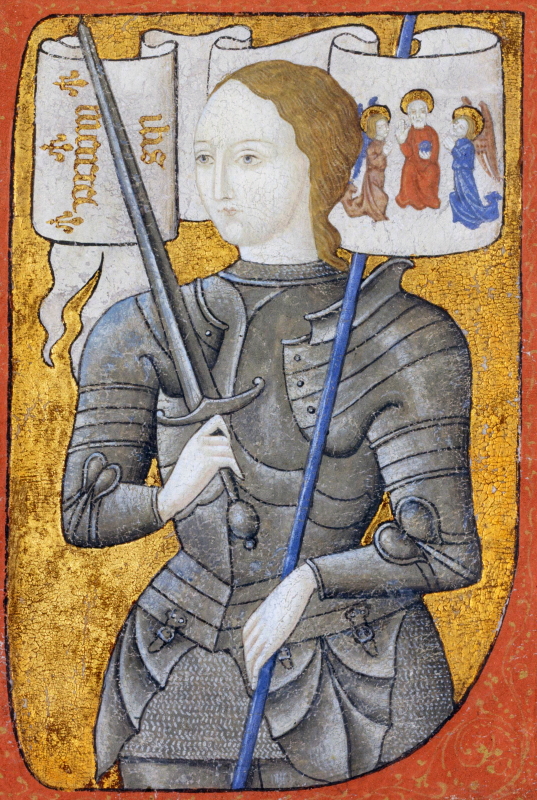 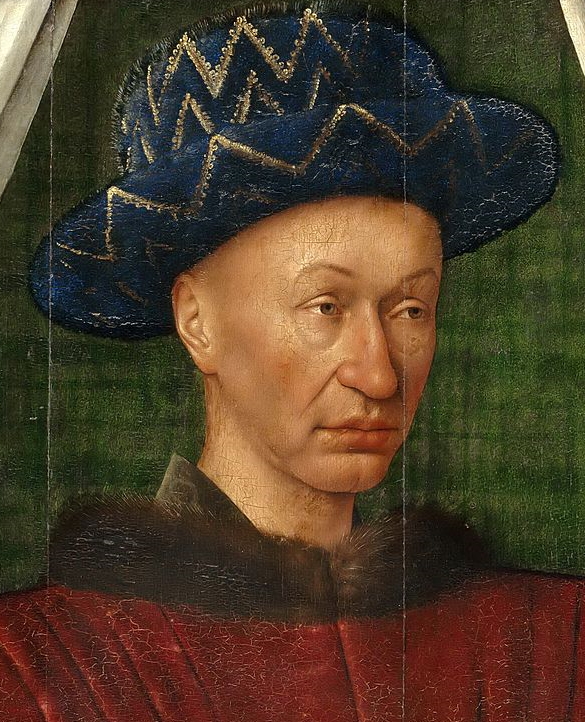 Joan of Arc and Charles VII
She was then turned over to a French ecclesiastical court (with strong
pro-English sentiments) in Rouen to be tried as a witch. After a
lengthy trial she was found guilty of sorcery and heresy and sentenced
to death. On May 30, 1431 (age 19) she was burned at the stake as
a witch.1
 For more on Joan of Arc For more on Joan of Arc
Charles then went on to get the powerful Burgundians to reverse course
and become allies of his (1435), develop a professional army of his own
(not dependent on feudal support of unreliable barons) – equipped with
cannons – and then defeated the English at the Battle of Castillon in
1453. From this point on, the English held no more territory in
France except at Calais just opposite England on the French coast.
The Hundred Years' War was finally over.
The ongoing Valois
The French kings who followed Charles, Louis XI (1461-1483)
and Charles VIII (r. 1483-1498), found themselves deeply involved in
the rather typical feuds over dynastic inheritances … and wars over
extended territorial claims – principally in Italy – wars which would
absorb both French and Italian politics for a half-century. When
Charles had no male heir, the crown then passed to a junior branch of
the Valois: the House of Orléans – the head of which was Louis
XII … King of France (r. 1498-1515), (briefly) King of Naples, and Duke
of Milan. Then when Louis had no male heir of his own, the
crown passed to his cousin (and son-in-law) Francis.
Francis I (r. 1515-1547)
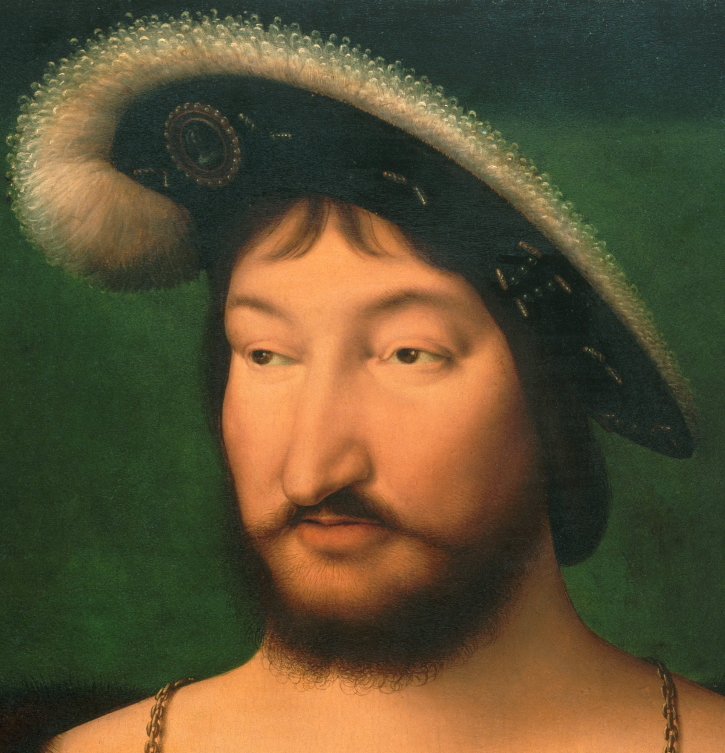 Francis,
in his long reign, would exemplify the Renaissance Man in French office
… a major patron of the arts and letters – even as he continued French
involvement in the affairs of Italy. At the same time, he found
himself facing a new challenge in the rising Habsburg family, led by
Charles … who started out as Dutch Lord (to the North), then by
inheritance became King of Spain (to the South), and finally by
election Holy Roman Emperor (to the East). Finding himself thus
surrounded by this rising Habsburg power, Francis attempted an alliance
with English King Henry VIII. But not getting anywhere in the
effort, he instead formed an alliance with the rising Ottoman Turkish
Empire in Southeastern Europe ... principally with its Muslim sultan,
Suleiman (the Magnificent)! Quite a bold thing for a Christian
sovereign to do! Francis,
in his long reign, would exemplify the Renaissance Man in French office
… a major patron of the arts and letters – even as he continued French
involvement in the affairs of Italy. At the same time, he found
himself facing a new challenge in the rising Habsburg family, led by
Charles … who started out as Dutch Lord (to the North), then by
inheritance became King of Spain (to the South), and finally by
election Holy Roman Emperor (to the East). Finding himself thus
surrounded by this rising Habsburg power, Francis attempted an alliance
with English King Henry VIII. But not getting anywhere in the
effort, he instead formed an alliance with the rising Ottoman Turkish
Empire in Southeastern Europe ... principally with its Muslim sultan,
Suleiman (the Magnificent)! Quite a bold thing for a Christian
sovereign to do!
But truly, he was a king as interested in Renaissance culture as he was
in the dynastic squabbles of the Renaissance sovereigns. Thus he
is still well known for his love of cultural refinements: art and
architecture,2 fancy social occasions, etc. ... but also a certain
decadence that accompanied his fancy lifestyle.
Nonetheless, Louis assembled a huge library of books (requiring a copy
of every book published in France!) and historical manuscripts (which
he apparently took the time to actually read) … then brought in
scholars to study and discuss these works.
In the realm of architecture, he built (by da Vinci's own design) the
fabulous Château de Chambord. He also rebuilt the Louvre Palace
in Paris and the Chateau de Fontainebleau – converting them from
medieval structures to Renaissance beauties.
He also founded the port city of Le Havre – sending out ships to
America and the Far East … in competition with the Spanish and
Portuguese, despite the monopoly that the papacy had established for
these two powers through various papal bulls. Thus in 1524, under
Francis's sponsorship, Giovanni da Verrazzano reached today's New York
City, then headed north … to claim Newfoundland for Francis. In
1534 Francis sent Jacques Cartier to explore Quebec … then in 1541
Roberval – to begin the French settlement of Canada … and the region's
conversion to Catholicism.
However, the realm of European politics proved highly problematic for
Francis. In 1525 he and his army suffered a massive defeat in
Italy at the hands of the Charles I's Spanish troops. Francis was
then taken to Madrid as a prisoner and released only the following year
after he agreed to humiliating terms (including his abdication, the
surrender of all French holdings in Italy, and the delivery of his two
oldest sons as hostages to Charles's court) ... which, once free, he
largely refused to honor. However only after paying two million
gold crowns to Charles did he got his sons back (four years
later). Then his war with Charles was resumed in 1536 – in
alliance with the Turks – and continued all the way to Francis's death
in 1547.
1Almost
immediately it was recognized that rather than being a witch she had
been in fact a true agent of God. Over the centuries her
popularity grew until in 1920 she was canonized as a saint by Pope
Benedict XV.
2Francis was a
great importer of Italian Renaissance art ... including even the person
of da Vinci, who served Francis during the first three years of the
king's reign (1516-1519) ... which was also the last three years of the
aging artist's life.
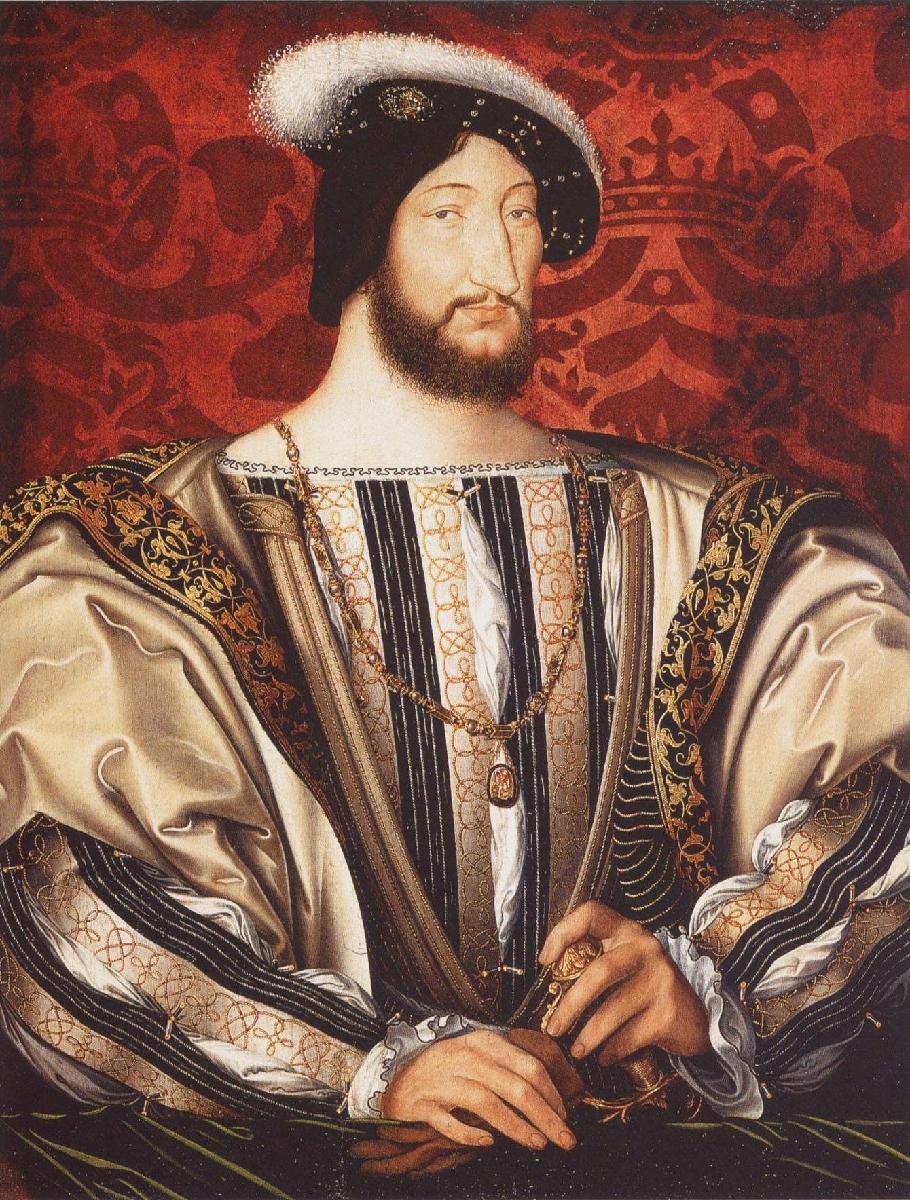
Francis I – by Jean Clouet (c. 1530)
Louvre Museum - Paris
|
The War of the Roses (1455-1487)
The humiliating English loss in the Hundred Year' War resulted in a
split within the Plantagenet dynasty between two factions: the
House of Lancaster – identified by its red rose on in heraldic shield –
and the House of York – thus identified by its white rose) … a horrible
dispute which came to be known as the "War of the Roses."
But the dynastic rivalry was anything but an internal English civil war
… with the Lancastrians supported by the kingdoms of Scotland and
France, and the Yorkers supported by the Burgundians – with the duchy
of Brittany switching sides.
Henry VII (r. 1485-1509)
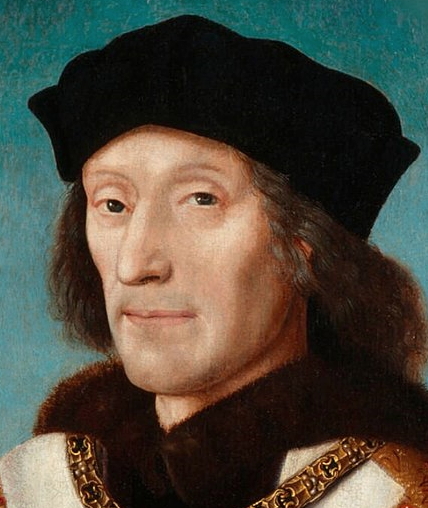 In the end, the only thing that the 32-year war achieved was the
destruction of the Plantagenet family – both sides – thus opening the
door for the House of Tudor, led by Henry Tudor, which in a victory at
the Battle of Bosworth Field (1485), gained the crown for him and his
Tudor family. As actually a "Lancastrian," Henry married
Elizabeth of York the following year, bringing the royal families
together ... and moving England forward in a fresh period of peace –
and thus prosperity – which Henry used (often corruptly) to work to his
personal advantage. In the end, the only thing that the 32-year war achieved was the
destruction of the Plantagenet family – both sides – thus opening the
door for the House of Tudor, led by Henry Tudor, which in a victory at
the Battle of Bosworth Field (1485), gained the crown for him and his
Tudor family. As actually a "Lancastrian," Henry married
Elizabeth of York the following year, bringing the royal families
together ... and moving England forward in a fresh period of peace –
and thus prosperity – which Henry used (often corruptly) to work to his
personal advantage.
Once king, he proved to be a cautious but very focused ruler in the
matters of the royal finances … putting them, through careful tax
measures, back on a firm footing. He rebuilt English power in his
support of the independence of Brittany against an expansionist
France. He also helped build English industry and trade in the
way he took challenged and then allied with competitors in that field,
the Flemish or Dutch.
Henry VIII (r. 1509-1547)
 Henry's son (also a Henry) had the ongoing task of trying to keep the
English barons under royal control ... and coming up with a male heir
to receive the Tudor legacy. He had married the aunt of Spain's
King (and also Holy Roman Emperor) Charles ... a strategic move for the
Tudors. But Catherine of Aragon had succeeded in delivering only
a girl, Mary. Henry's son (also a Henry) had the ongoing task of trying to keep the
English barons under royal control ... and coming up with a male heir
to receive the Tudor legacy. He had married the aunt of Spain's
King (and also Holy Roman Emperor) Charles ... a strategic move for the
Tudors. But Catherine of Aragon had succeeded in delivering only
a girl, Mary.
Like his father, Henry was not a man of chivalrous scruples (something
more like Machiavelli's Prince ... which was becoming more the norm in
political high places). He needed a son and would do whatever was
necessary to secure one. He finally divorced Catherine (not only
straining the relationship between Henry and Charles but also between
Henry and the Pope ... who refused to annul Henry's marriage to
Catherine).
Thus Henry broke from Rome and declared himself (instead of the Pope)
the head of the Church in England. Then to augment his treasury
he not only ended all payments to Rome, he proceeded to seize the
treasuries of wealthy English monasteries, selling their lands to
various English supporters (including members of the rising merchant
class) seeking entry into – or advancement within – the ranks of the
aristocracy. Not only did this make the Tudor monarchy rich and
powerful, those who received such lands (including Henry himself) were
a guarantee that the Roman Church would be hotly resisted in England in
any attempt to retake its lost position. While all of this did
not put England into the Protestant camp (Henry was highly opposed to
Luther's reforms … though later he took some steps in the Protestant
direction) it certainly helped open the way for Protestantism to find a
foothold there.
In any case, further marriages (six in total!) proved no more
successful in delivering Henry a strong male child to continue the
Tudor line. His sickly son Edward3 died at age sixteen after only
six years of official – though hardly effective – rule.
Henry could be ruthless to those who fell out of favor, Cardinal Thomas
Wolsey, his Lord Chancellor (Prime Minister) dying on his way to London
to be tried (and most certainly executed) for "treason" after failing
to secure the annulment with Catherine. Likewise, his
replacement, Thomas Cromwell was executed for treason soon after
arranging a brief and "unconsummated" marriage with an unattractive
German princess. At least his Archbishop of Canterbury,
Thomas Cranmer, would die of such charges not by Henry, but by his
daughter Mary. Politics in England was a very dangerous
game.
But politics abroad was just as dangerous … as Henry found himself
constantly involved in wars and shifting alliances with Francis of
France, Holy Roman Emperor and Spanish King Charles, or with the
Scottish King James. In the end, all that this activity
accomplished was merely the emptying of Henry's royal treasury.
3Edward was born of Henry's third marriage – with Jane Seymour… who died soon after giving birth to Edward in 1537.
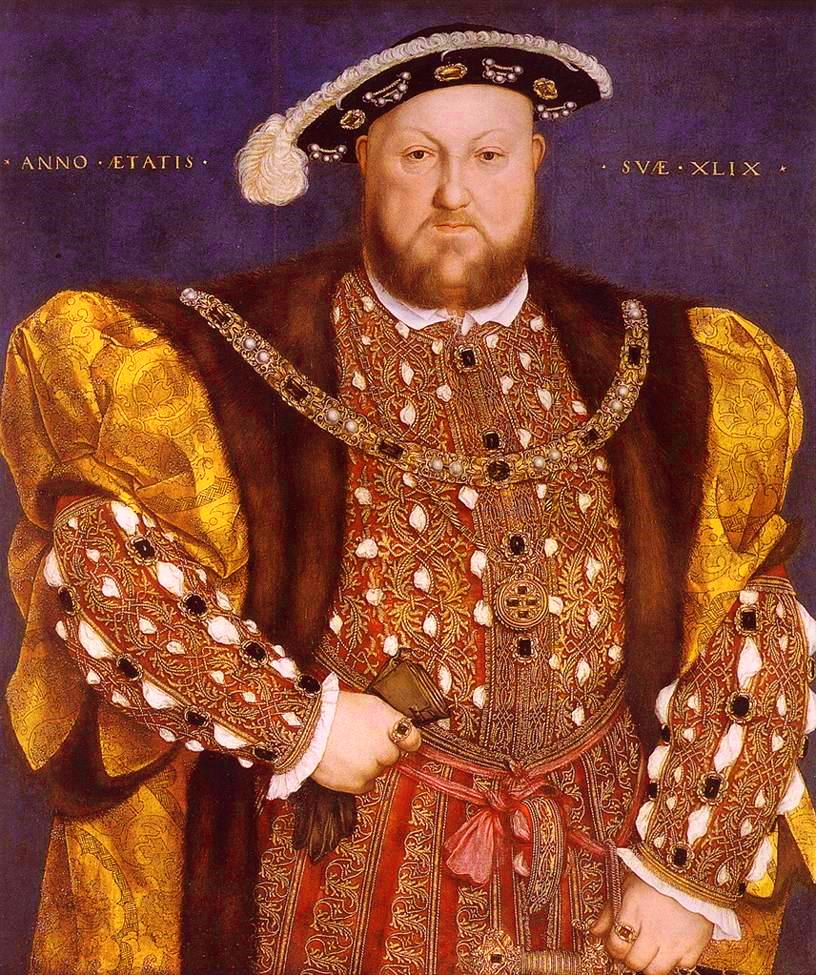
Henry VIII – by Hans Holbein the Younger (1540)
Galleria Nazionale d'Arte Antica - Rome
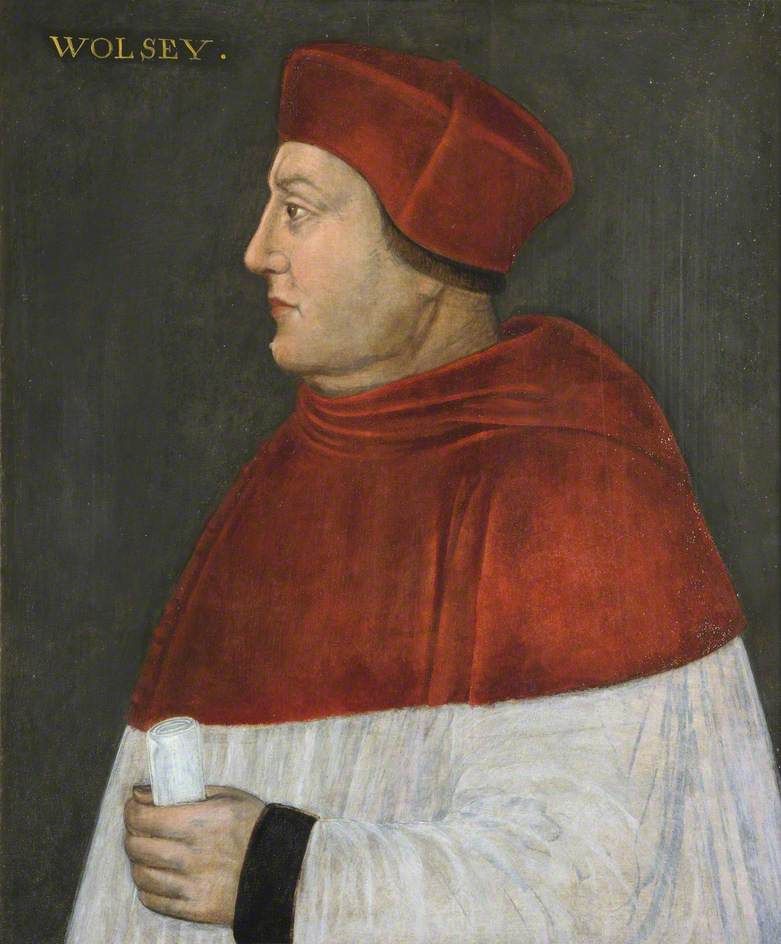
Cardinal Thomas Wolsey
Trinity College
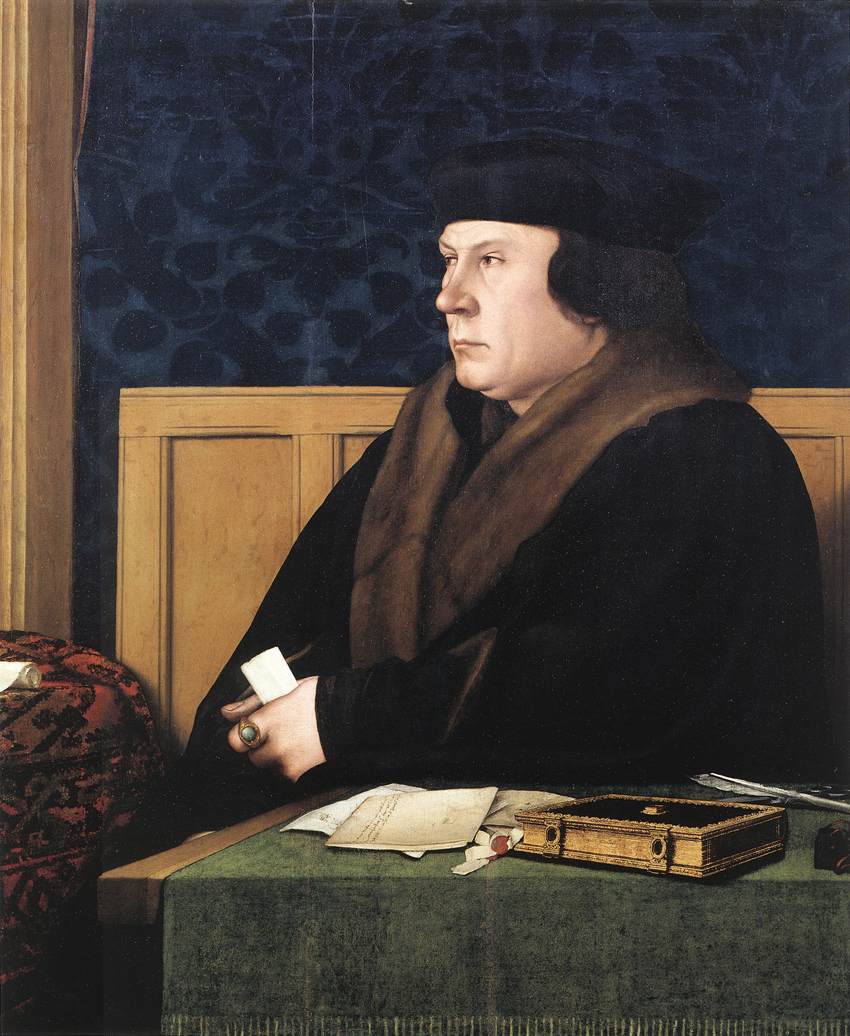
Thomas Cromwell – by Hans Holbein the Younger (1532-1533)
Frick Collection - New York City
The wives of Henry VIII
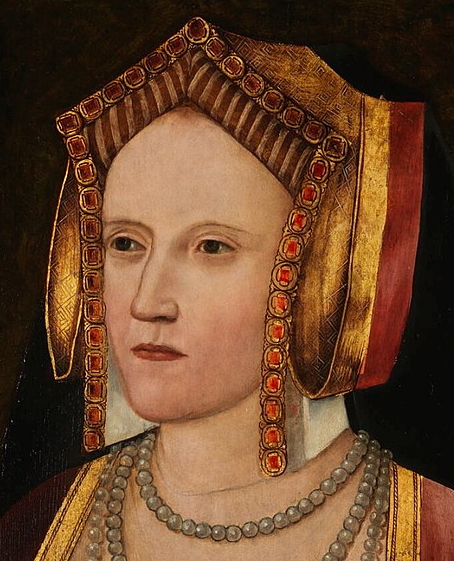
Catherine of Aragon (Queen - 1509-1533)
In 1533, Henry declared their marriage annulled ... because she had provided him with no
male heir, only a daughter Mary (and anyway, Henry had become infatuated with Anne Boleyn)
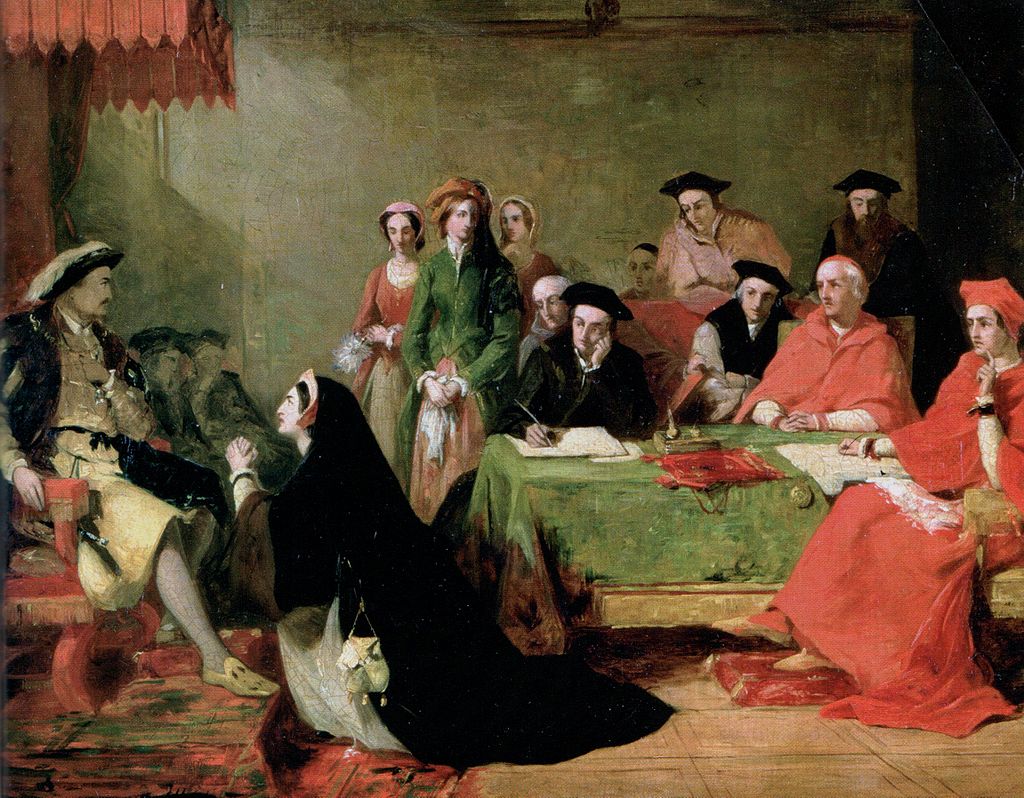
The Trial of Queen Catherine of Aragon - by Henry Nelson O'Neil (1846–1848)
Birmingham Museum and Art Gallery
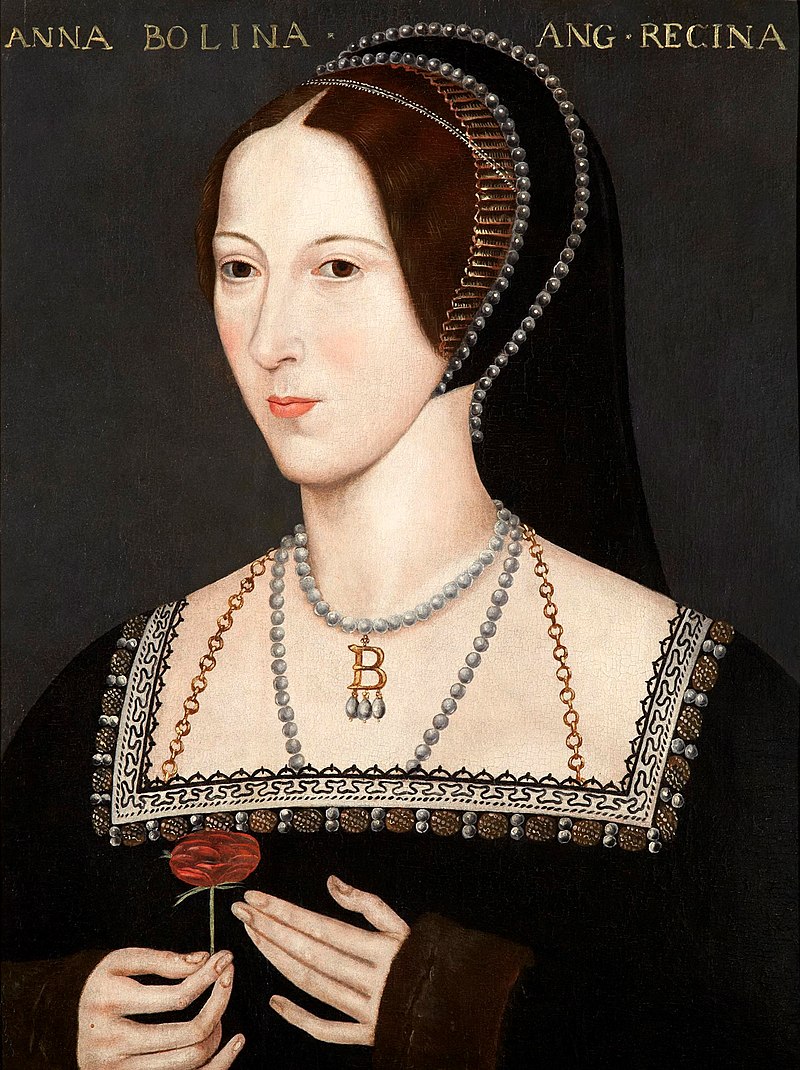
Anne
Boleyn – 1533-1536
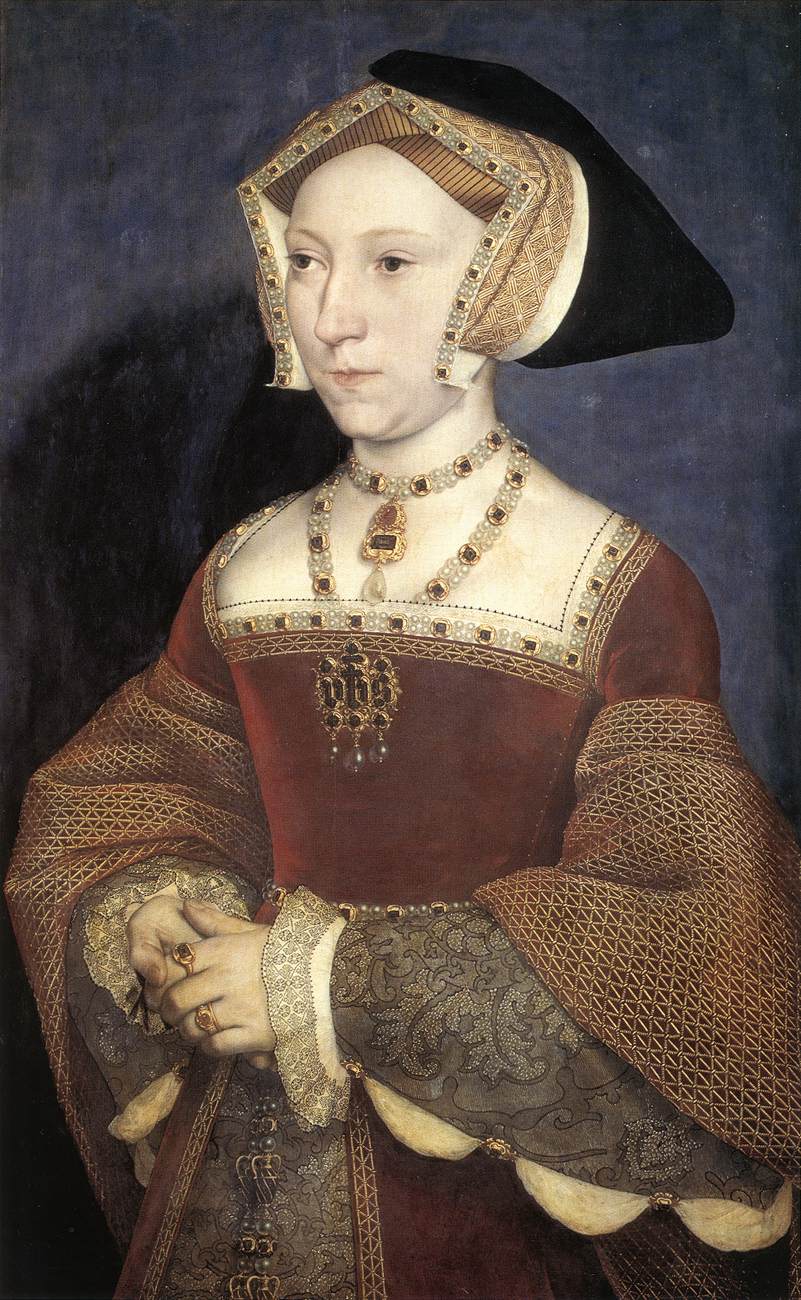
Jane Seymour – 1536-1537
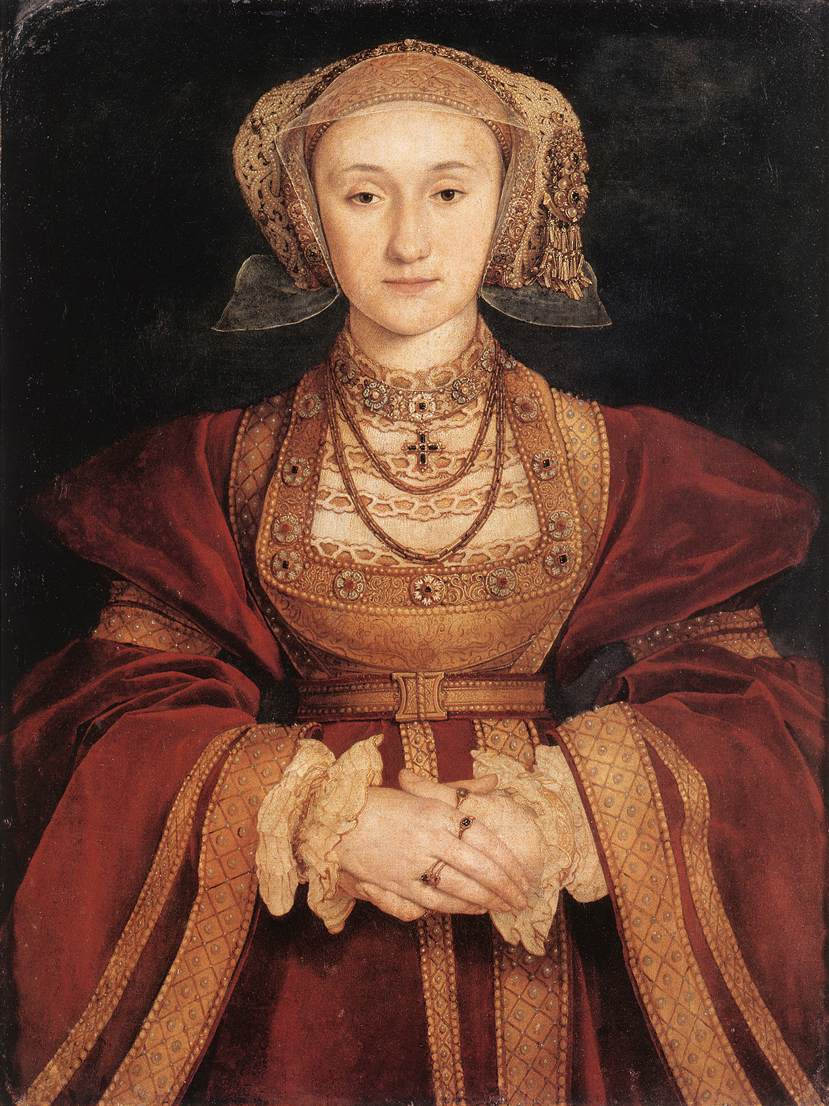
Anne of Cleves – 1540
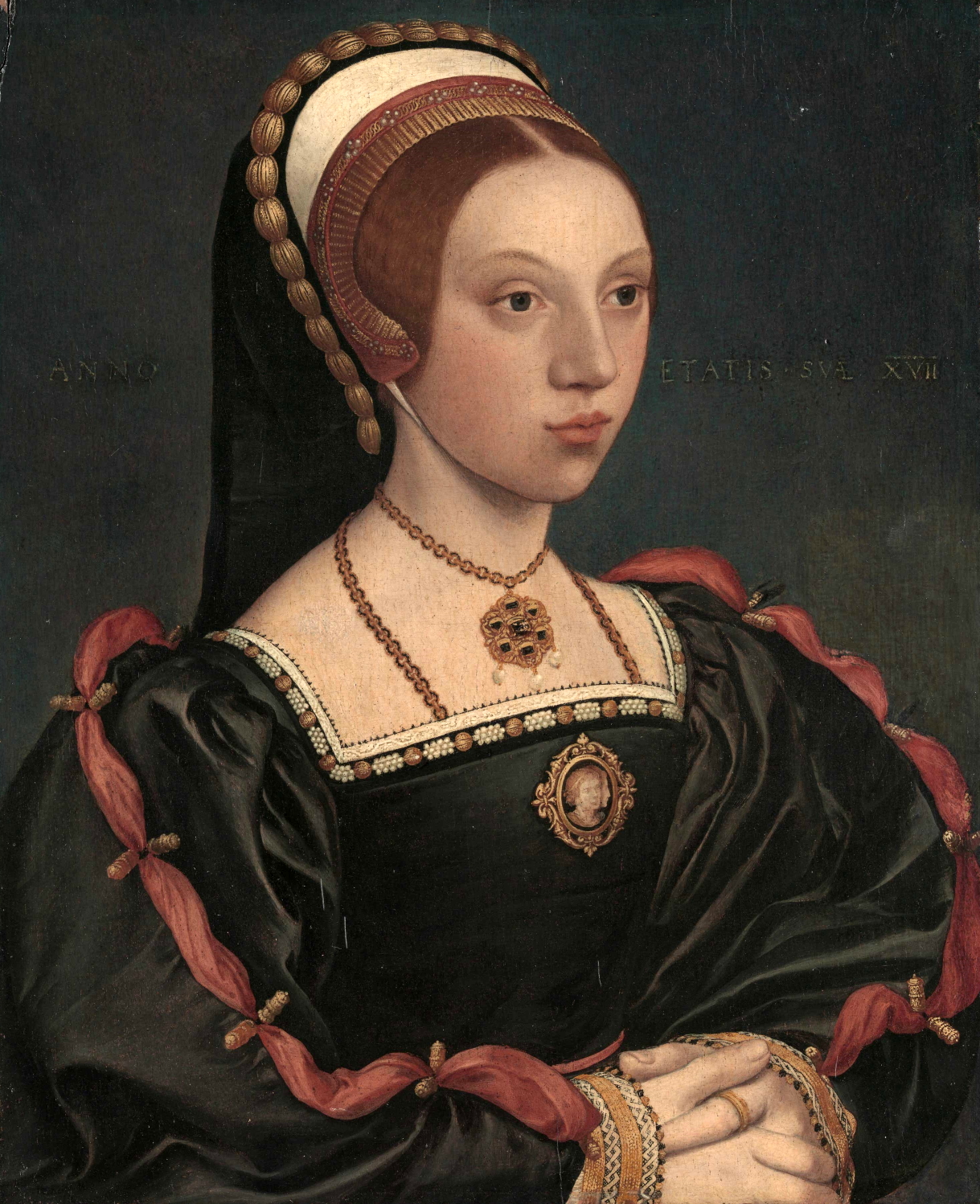
Catherine Howard –
1540-1541
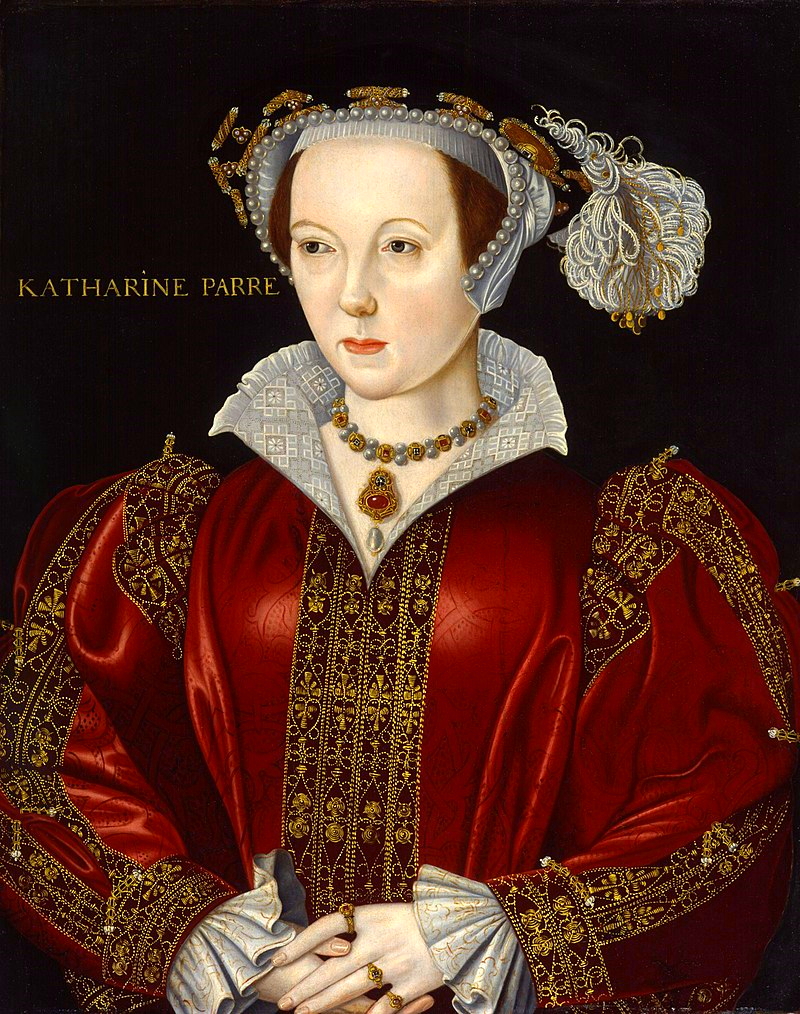
Catherine Parr – 1543-1547
|
Castile
At the heart of what would become the future "Spain" was the
ever-expanding kingdom of Castile. From its starting point in
north-central Spain it included (by inheritance of Ferdinand III in
1230) the equally large neighboring kingdom of Leon, making it by far
the largest political entity in Spain. Thereafter, and up until
1479, only the Christian kingdoms of Portugal (to the West) and Aragon
(to the East) and a fast-declining Muslim Grenada) (to the South
remained outside the huge Castile domain.
As was typical of the times, Castile, and its ruling House of
Trastámara, found itself constantly absorbed in dynastic infighting
over rights to the throne … as well as over baronial positions outside
the royal family itself.
Henry IV of Castile (1454-1474)
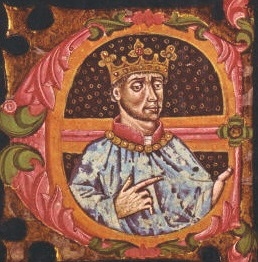 Henry was something of a combination of both the Castile and Aragon
legacies, his father John II of Castile and his mother Maria of Aragon
… although such a marriage did not yet unite those two kingdoms into
one. Besides … personally he was a very weak ruler, letting his
barons, notably the Duke of Trujillo, direct his political
affairs. Family feuds also shook his rule when he had his
childless marriage with Blanche of Navarre annulled and married his
first cousin Joan of Portugal (their mothers were sisters). But
Joan had an affair with a bishop … and this second marriage produced
only a female heir – herself of dubious origins. Henry was something of a combination of both the Castile and Aragon
legacies, his father John II of Castile and his mother Maria of Aragon
… although such a marriage did not yet unite those two kingdoms into
one. Besides … personally he was a very weak ruler, letting his
barons, notably the Duke of Trujillo, direct his political
affairs. Family feuds also shook his rule when he had his
childless marriage with Blanche of Navarre annulled and married his
first cousin Joan of Portugal (their mothers were sisters). But
Joan had an affair with a bishop … and this second marriage produced
only a female heir – herself of dubious origins.
Thus it was that Henry formally recognized his half-sister Isabella, as heir to the throne of Castile.
Aragon
We commonly identify Aragon as a huge region in Western Spain …
regained by Christian forces from the Muslims as they were pushed back
southward in the Spanish Reconquista. But actually, Aragon was
early on the seat of a much larger empire reaching across the
Mediterranean all the way to Greece. It was also, in typical
feudal fashion, constantly involved in a contest with other Spanish
families for dominion in Spain … and with the French for control of
Southern France – and ultimately also Southern Italy. This
Mediterranean dynasty and its empire reached the heights of its power
in the 1200s and just prior to the end of the 1300s, when it lost its
territory in Greece. But in 1442, it was able to take the huge
kingdom of Naples in Southern Italy from French Angevin control and
bring it into Aragon's Mediterranean empire.
Alfonso V of Aragon (r. 1416-1458)
 Bringing the Southern Italian Kingdom of Naples into Alfonso's Aragon
Empire was a very complicated diplomatic, as well as military matter
(employing some of the latest military technology) … as feudal lords,
Italian urban republics and ultimately the papacy became directly
involved in the process. But ultimate success in the matter made
Alfonso one of the leading political figures of his day. He too
proved to be a patron of the arts (he himself being an avid reader of
classic literature) … and once his reign was secure did much to better
the economic foundations of his empire. Bringing the Southern Italian Kingdom of Naples into Alfonso's Aragon
Empire was a very complicated diplomatic, as well as military matter
(employing some of the latest military technology) … as feudal lords,
Italian urban republics and ultimately the papacy became directly
involved in the process. But ultimate success in the matter made
Alfonso one of the leading political figures of his day. He too
proved to be a patron of the arts (he himself being an avid reader of
classic literature) … and once his reign was secure did much to better
the economic foundations of his empire.
But his marriage with his cousin Maria (their fathers were brothers)
proved childless … and thus his brother John (who had been governing
the Spanish holdings anyway) received title to his Spanish … and his
illegitimate son Ferdinand title to his Kingdom of Naples.
Ferdinand I of Naples (r. 1458-1494)
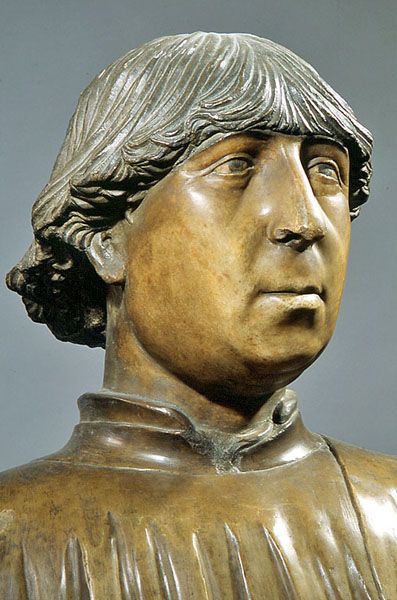 Ferdinand would go on to be a dominating figure in Italian – and
European – politics, involving not only the French, the papacy, the
powerful Venetian Empire, and other Italian city-states but also the
rising power in the Eastern Mediterranean of the Ottoman Turks. Ferdinand would go on to be a dominating figure in Italian – and
European – politics, involving not only the French, the papacy, the
powerful Venetian Empire, and other Italian city-states but also the
rising power in the Eastern Mediterranean of the Ottoman Turks.
And he would turn his kingdom away from its political dependence on
feudal barons … and instead on the rule of law defended by a growing
royal estate – something that would become the trend of the times as
Europe moved away gradually from feudalism into royal absolutism.
But, like his father, he was also a major patron of the arts …
something considered extremely important in the thinking of Renaissance
Europe.
John II of Aragon (r. 1458-1479)
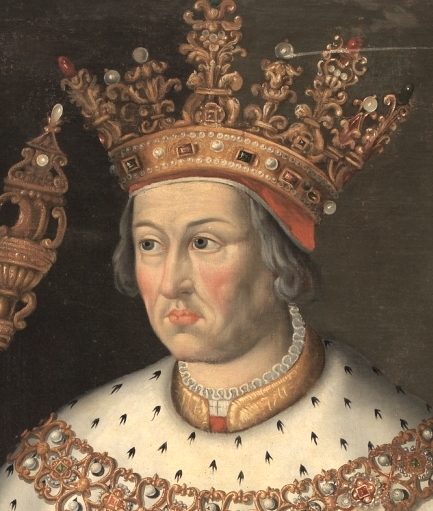 Alfonso's brother John would come to hold several titles: King of
Aragon, King of Navarre, and King of Sicily. But in his case too,
family conflicts over titles and jurisdictions would trouble his rule …
resulting even in civil war (the Navarrese Civil War and the Catalan
revolt) … as well as an ongoing fight with the French monarchy. Alfonso's brother John would come to hold several titles: King of
Aragon, King of Navarre, and King of Sicily. But in his case too,
family conflicts over titles and jurisdictions would trouble his rule …
resulting even in civil war (the Navarrese Civil War and the Catalan
revolt) … as well as an ongoing fight with the French monarchy.
Overall, his greatest success as king was in having his son Ferdinand
betrothed to the heir to the Castilian throne, Isabella at a very early
age ... although this would be deeply challenged by other
fortune-seeking families.
Finally: Spain!
Ferdinand II of Aragon (1479-1516)
and Isabella I of Castile (r. 1474-1504)
At the end of the 1400s things came together for Spain in a dazzling
way. With the marriage of cousins Ferdinand and Isabella,
popularly termed "The Catholic Monarchs"4 – thus producing the union of
Castile and Aragon – Spain's rise in importance began in earnest.
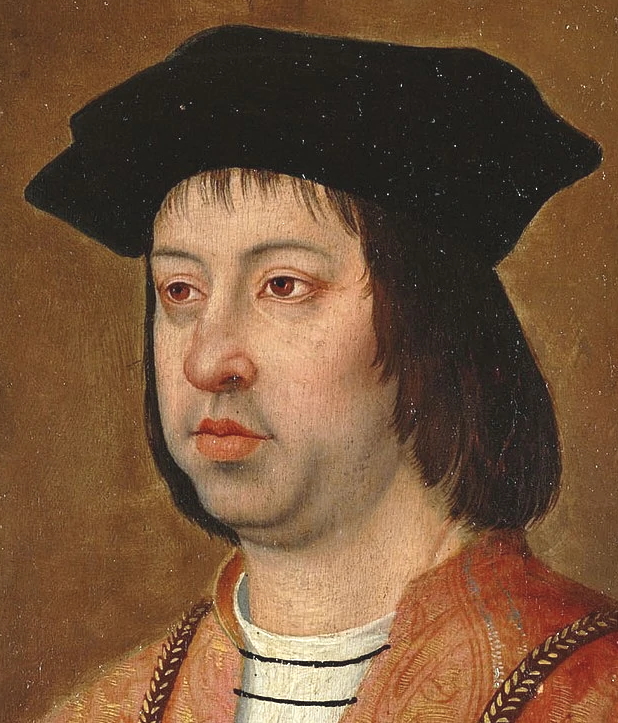 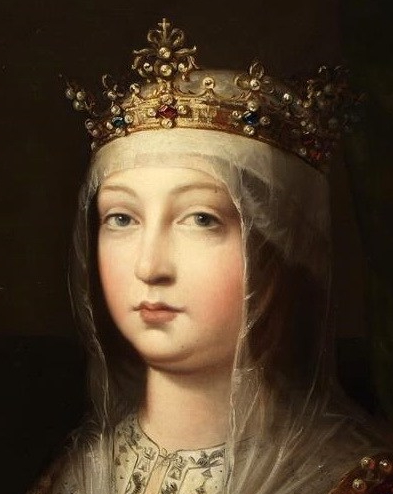
Ferdinand inherited all the Aragon titles (Aragon, Sardinia, Sicily,
Naples and Navarre) and, by way of marriage, King of Castile and
Leon. He would of course have to fight to make good his claim to
Naples and Navarre. Catalonia would also challenge his
claim. And there would be battles within the family for this or
that claim as well. But he proved to be a tough warrior.
Isabella, after many efforts were made to marry her off to this or that
individual and, after securing (questionably) a papal bull allowing
these cousins to marry, she and Ferdinand snuck away to get married in
1469. Then upon receiving the throne at her half-brother Henry's
death in 1474, she had to face all sorts of challenges to her right to
the throne … including even a war with the Portuguese – which dragged
on for years, on the land and on the sea. And the Portuguese
seemed to be able to hold onto the claim that the Atlantic belonged
solely to the Portuguese to exploit.
But the Genoese naval explorer Columbus was able to secure support from
Isabella for a venture he claimed would give Spain access to the Far
East, by heading West across the Atlantic. His subsequent
discovery of America in 1492 would then give Spain a countering claim
to Portugal's Atlantic monopoly … leading to an agreement, the Treaty
of Tordesillas5 (1494), between the two powers as to which part of
the Atlantic venture belonged to which of the two powers – and had it
endorsed in 1505 by Pope Julius II. In this treaty it was agreed
that all land to the east of a line of longitude – thus constituting
something of an eastern hemisphere – would be Portugal's to
exploit. All lands in the western hemisphere would be Spain's to
exploit.
The year 1492 was also a very big year for the Spanish in another
way: it marked the military defeat of the Muslim Kingdom of
Grenada … and the completion of Spanish expansion across the Iberian
Peninsula (Portugal, of course excepted). The Muslims (Moros) –
along with the Jewish population in Spain – would subsequently be
expelled from Spain … unless they agreed to convert to Christianity.6
Indeed, in 1478 Isabella had established the Spanish Inquisition … to
hunt down those who could not be considered "authentic" Christians
within the Spanish realm. And after the decision to force the
conversion of Jews and Muslims, the Inquisition found itself focusing
in particular those who had converted from Judaism or Islam to
Christianity – and whose "conversion" was highly suspect.
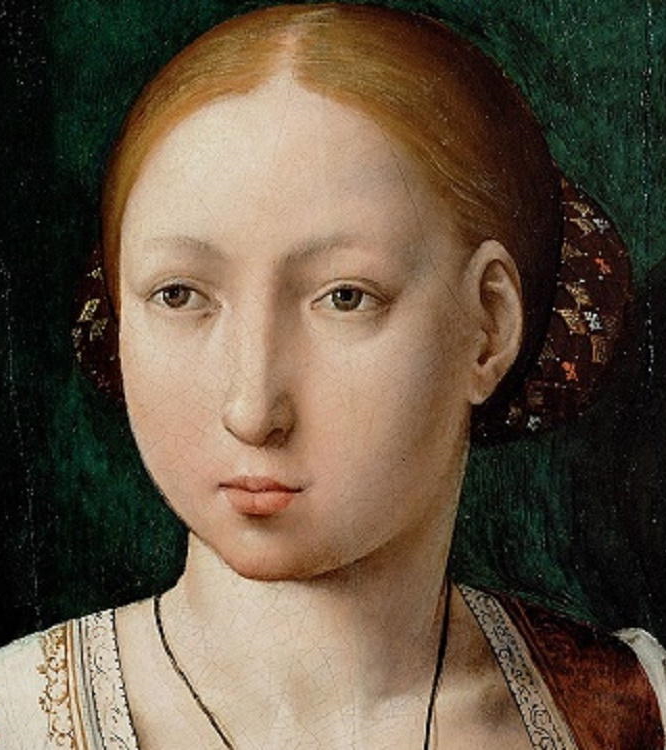 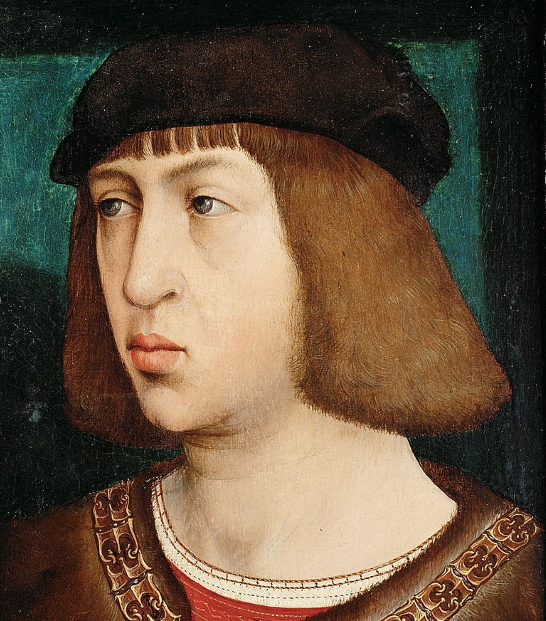
"Mad" Joanna of Castile and Philip "The Handsome" of Habsburg
Ferdinand and Isabella's daughter and sole surviving heir unexpectedly ended up being their daughter Joanna – who had
married Philip of Habsburg. She was reputed to be insane, supposedly driven mad by the death of so many family members around her – and because of her husband's constant infidelities. She was thus institutionalized – placed in isolation at a convent ... and held there until she finally died at age 75.
Charles of Habsburg (1500-1558)
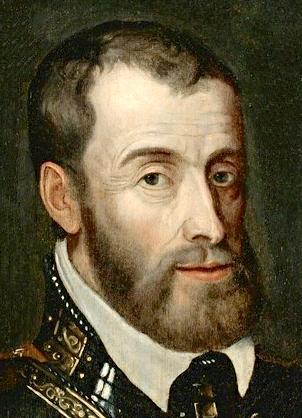 This allowed her sixteen-year-old son Charles (who actually had grown up in his
father's Habsburg land of Dutch-speaking Flanders) to take the throne directly as Charles I, King of Spain ... and three
years later the vast Habsburg holdings in the Netherlands, Burgundy and
Germany as Charles V, Holy Roman Emperor – and Archduke of Austria. Charles also received title to the
Spanish lands in Southern Italy ... and the popes also named him King in Germany (Pope Leo X) and King in Italy
(Pope Clement VII). This undoubtedly made him the most powerful
monarch in Europe. This allowed her sixteen-year-old son Charles (who actually had grown up in his
father's Habsburg land of Dutch-speaking Flanders) to take the throne directly as Charles I, King of Spain ... and three
years later the vast Habsburg holdings in the Netherlands, Burgundy and
Germany as Charles V, Holy Roman Emperor – and Archduke of Austria. Charles also received title to the
Spanish lands in Southern Italy ... and the popes also named him King in Germany (Pope Leo X) and King in Italy
(Pope Clement VII). This undoubtedly made him the most powerful
monarch in Europe.
Added to this was the constant flow of gold
from his vast Spanish holdings in America, making Charles also (at
least potentially) the wealthiest man in Europe. But his wars
were very, very costly.
Charles also was a major player in the Catholic Counter-Reformation against
the Protestants … in particular in his effort to silence the German
"nuisance" Luther. As imperial "Defender of the Faith," he
supported strongly the three popes who presided over the Council of
Trent (1545-1563), called to tighten the definitions of Catholic
theology and practice. He supported also the creation of the
Jesuits, a special order of soldier-priest-monks called to teach and
enforce papal doctrine ... and in the process to retake from the
Protestants as much territory of Old Christendom as possible in order
to place it back under papal control.
All of this kept him busy traveling from state to state within the Holy
Roman Empire and his Spanish territories (he never established a
capital city of his own). He assisted Venice in its defense
against the Turks … but was not able to hold off the Turks in their
assault on Budapest in Hungary.
And as far as the Spanish holdings in America went, he managed land
assignments there along traditional feudal lines … but also sent
priests to his American colonies – to bring them into the Catholic
Church … and to protect them as "his subjects" against massive
exploitation by the local Spanish lords. Thus to the mix of a
rising Spanish feudal system in America in which Spanish noblemen ruled
the surrounding land and its inhabitants from their feudal manors or
"haciendas," Charles added the political oversight of his colonies
through the church's hierarchy of priests and bishops. These were
called on to help keep the American social order under the control of
the political authority back in Spain.
At the same time, he moved Spain into position as major commercial
competitor with the Portuguese in the African slave trade with the
Caribbean Islands. Slaves were not of the same political-legal
order as the peasants (Hispanic or Indian) … and thus did not receive
the same royal protection.
Then, most oddly, in 1556 Charles simply stepped down from his
positions, turning over the rule of Spain to his son Philip and the
Holy Roman Empire to his brother Ferdinand. Now the Habsburgs had
two parallel dynasties – generally fairly cooperative with each
other. The Charles retired to a monastery … and died the
following year (1558).
4Pope
Alexander VI (himself a Spaniard) gave recognition to these two
monarchs as vital "defenders of the faith" by giving them the title,
the Most Catholic Monarchs. It was a title that they and their
descendants were particularly proud of.
5The line, running
approximately 46 degrees west by today's measure, basically assigned
all of the Americas to Spain … except for the coastline extending east
into the Atlantic – which comprises most of today's Brazilian coastline.
6The Spanish Inquisition would continue its work all the way up until it was finally abolished in 1834.
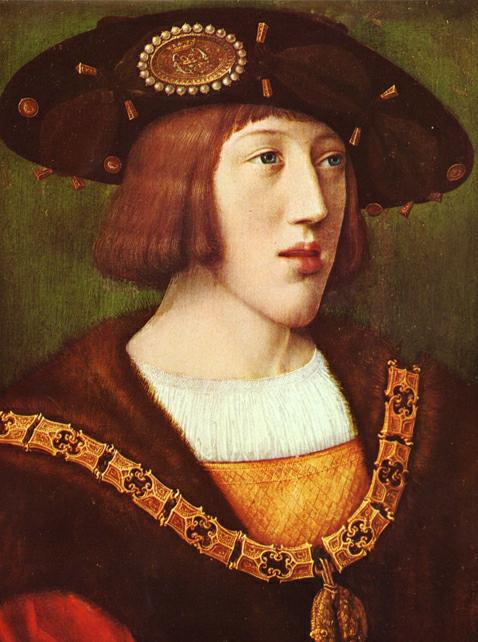
A young Spanish King / Holy Roman
Emperor Charles V of Habsburg
Paris, Musée du
Louvre
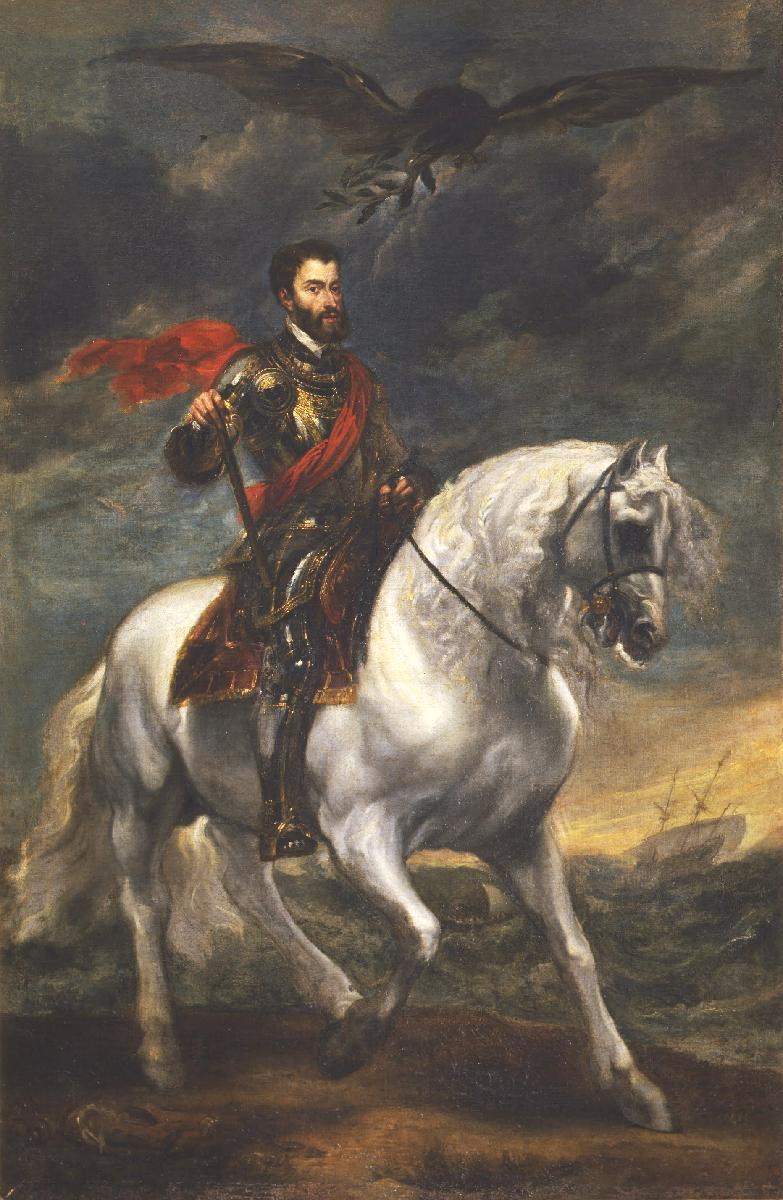
Charles I (Spain) and V (Holy Roman Empire) - by Anthony Van Dyke (c. 1620)
Galleria degli Uffizi, Florence
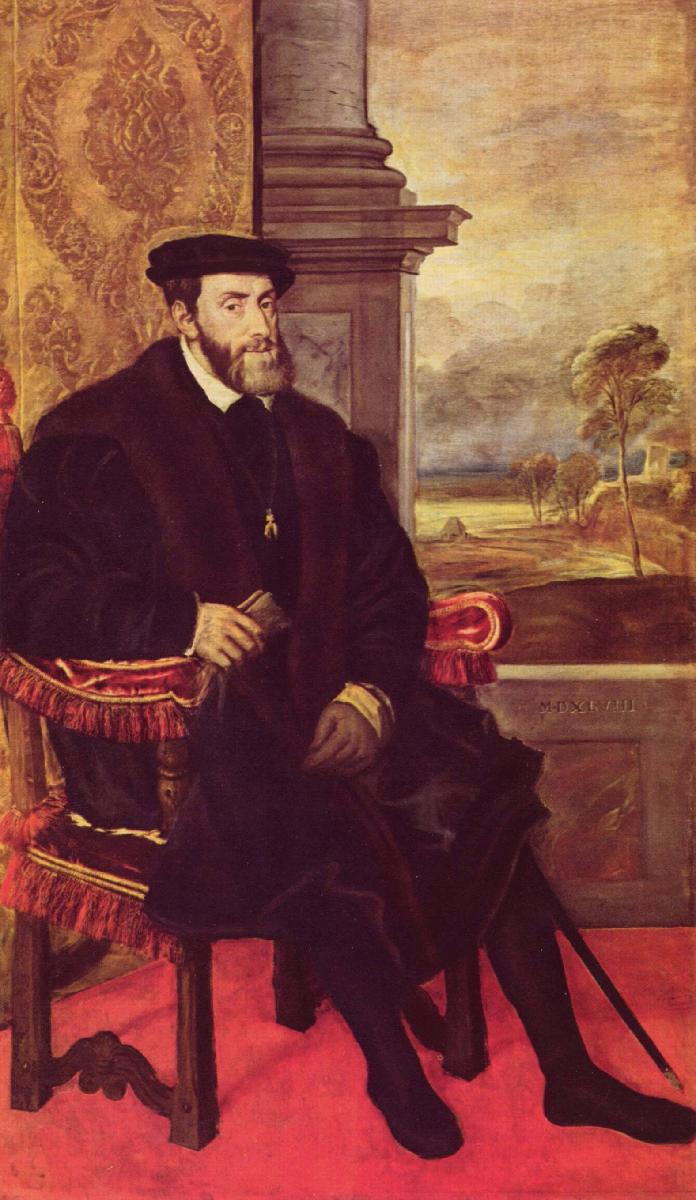
Charles V, Holy Roman Emperor
(1548)
traditionally attributed
to Titian, today attributed to Lambert Sustris
Munich, Alte
Pinakothek
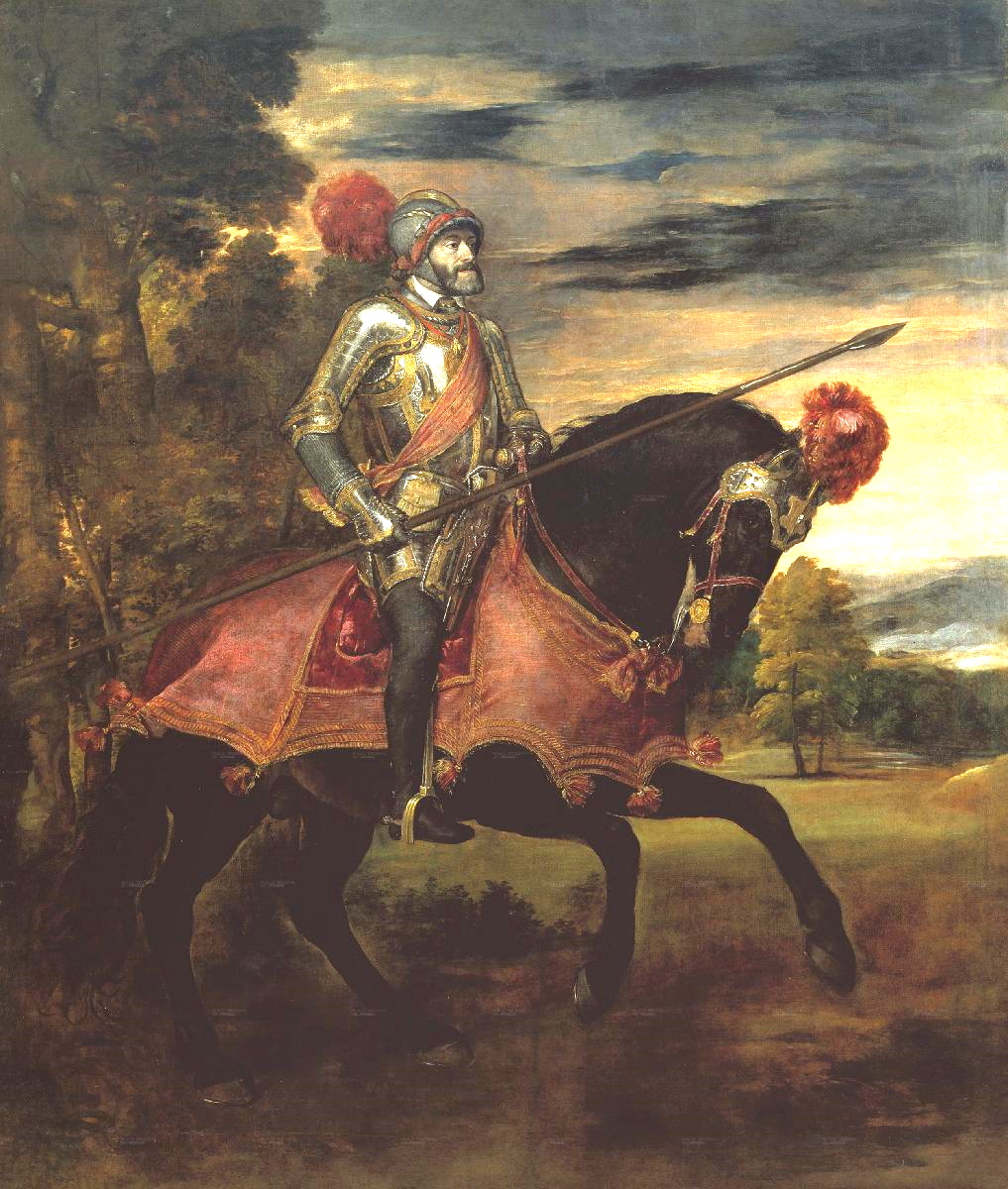
Charles V at Mühlberg
- by Titian (1548)
Madrid, Museo del
Prado
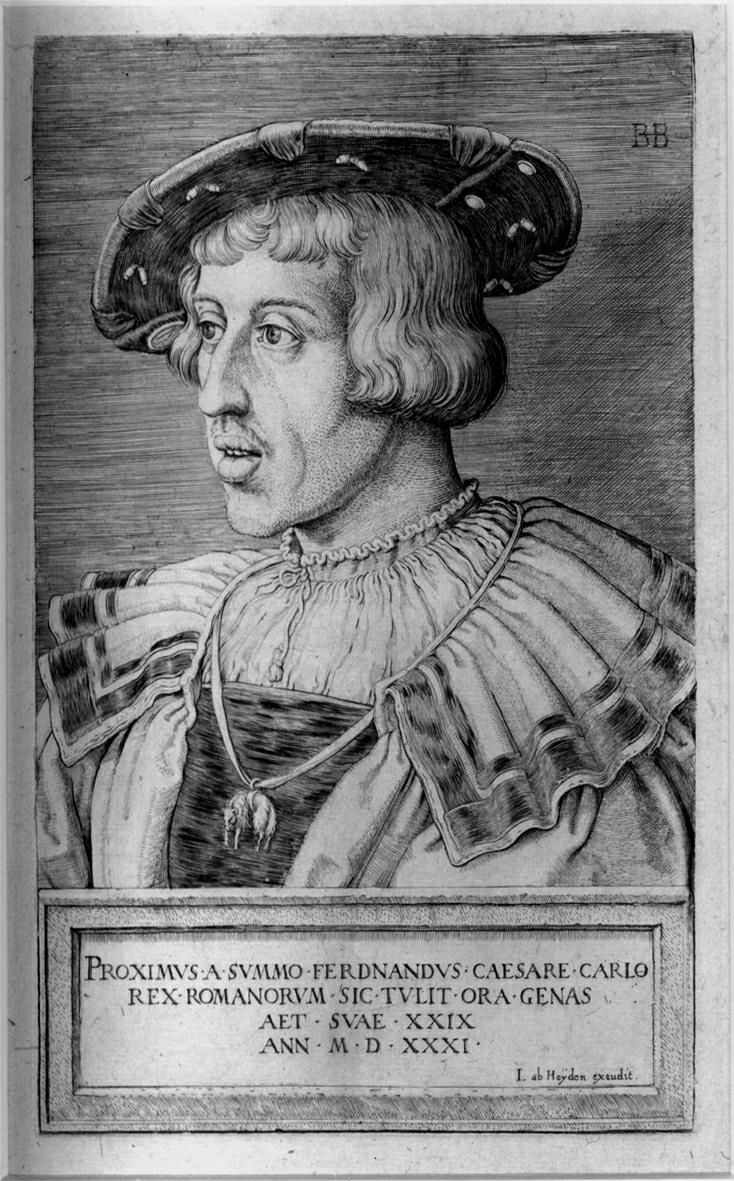
Charles's brother Ferdinand I (1531) - by Barthel Beham
Ferdinand in 1531, the year
of his election as King of the Romans
Private collection
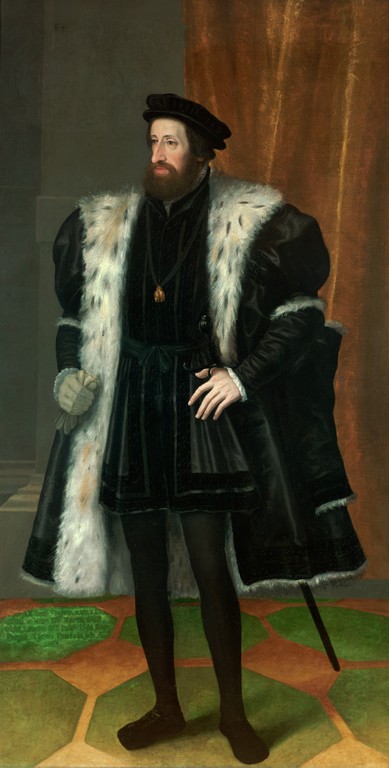
Ferdinand I (1503-1564) -
Holy Roman Emperor (1558-1564)
- by Hans Bockberger the Elder
Ferdinand had been serving his
older brother Charles V as his stand-in
in the Holy Roman or Eastern Empire
(Österreich) since the 1520s
Kunsthistorisches Museum
- Vienna
VENICE:
THE EARLIEST OF THE GRAND ITALIAN STATES |
At
the time of the Renaissance, Italy was not a nation, but instead a
territory with varying political systems … under constant dispute for
control among various dynasties, French, Spanish, German as well as
Italian. Southern Italy, with its political center at Naples, was
under what had to be considered "Spanish" or Aragonese dynastic rule …
challenged by French political interests. Northern Italy, with Milan
as the leading city, was under local rule … except when the French were
attempting to bring the region under French rule. Then there was the
huge territory in Central and Eastern Italy identified as the "Papal
States" and under direct papal rule … the papacy changing hands
constantly as various families vied for this very important position.
Then there were the "republics" or city states of Northwestern Italy …
Florence, Siena, Pisa, Mantua, Ferrara, Verona (and, at times, Milan)
belonging to this category. Then, as we have seen, there were the huge
maritime domains of Genoa and Venice located at the upper edges, East
and West, of the Italian peninsula.
Thus it is very hard to "summarize" Italian politics during this period
… except to say that dynastic conflicts and the ongoing battle between
the Guelf and Ghibelline coalitions were constant and quite violent.
|

A view of Venice
Scala -
Florence 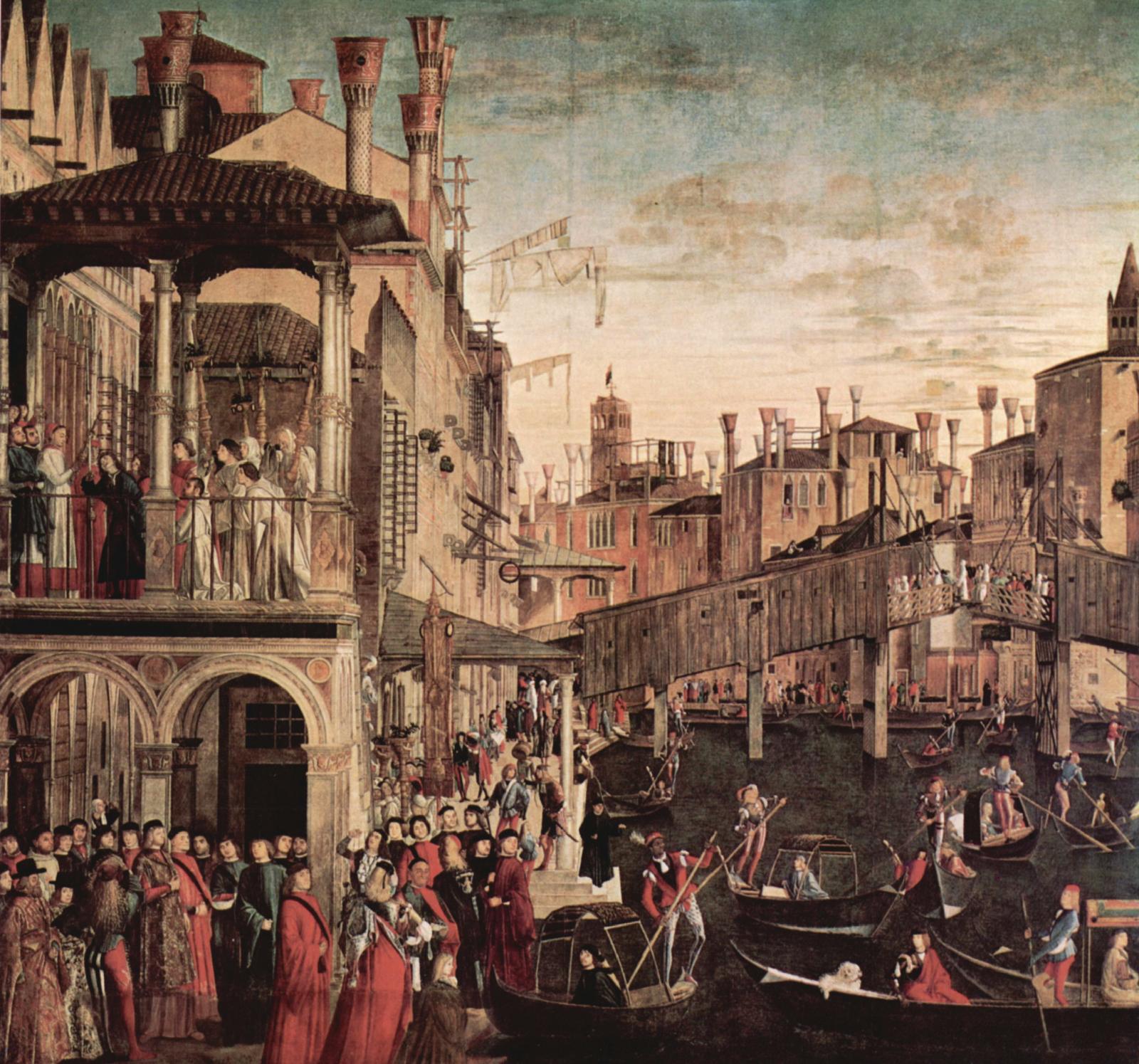
Members of the Vendramin
Family Venerating a
Relic of the True Cross
- by Vittorio Carpaccio -
1494
Accademia of Venice

The Venetian Doge (1501-1521)
Leonardo Loredan - by Belinni
National Gallery - London 
Doges' Palace, Venice (1330s
and 1400s)
(facade on the jetty, 1300s;
balcony 1404; facade on the Piazzetta,
1424-1442) 
Canaletto - The Doge's Palace –
Venice (ca. 1730)
The Royal Collection -
Windsor Castle 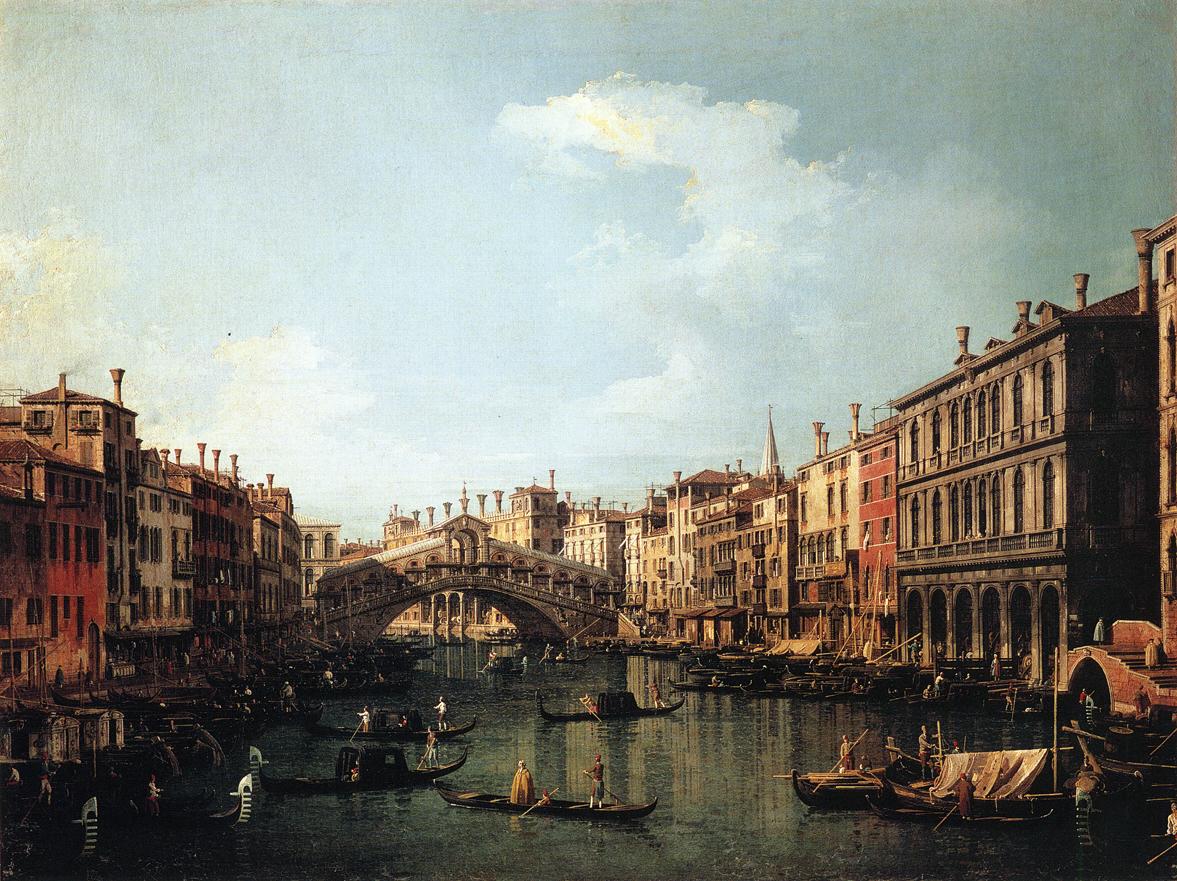
Canaletto - The Rialto Bridge from the
South
Rome, Galleria
Nazionale d'Arte
Antica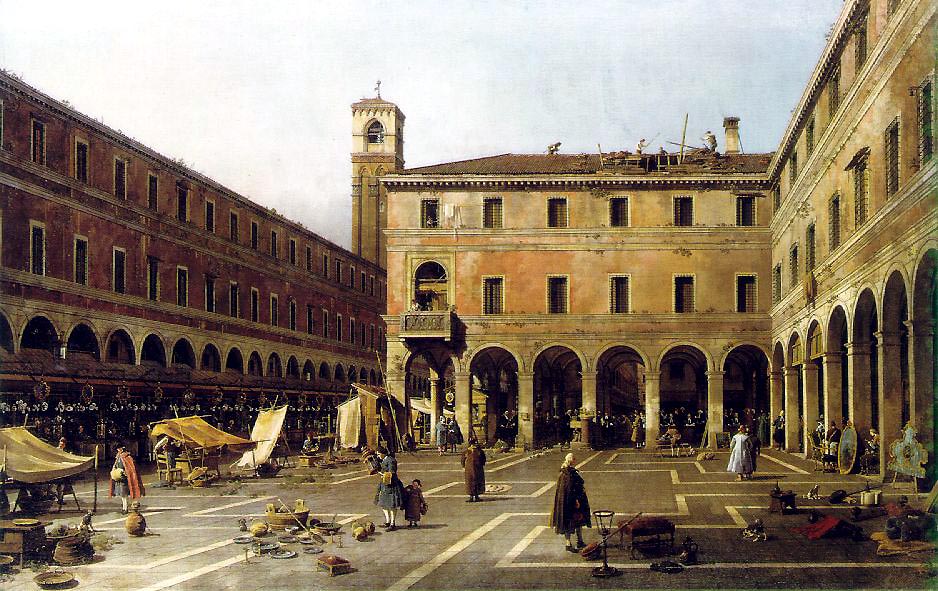
Canaletto - The
Campo di Rialto – Venice (ca.
1730)
THE MEDICI
AND RENAISSANCE FLORENCE |
|
Siena
It was Siena, not Florence, that first took the lead in the development
of the very progressive and enormously prosperous region of Tuscany
(the name derived from the ancient Etruscans based there). The town of
Siena was the location of a university dating back to 1240, the city
prospered enormously from the salt, mining and wool trade … and from
the banking business supporting this wealth in trade. And it was
governed by its own Republic (founded in 1125) … until 1555, when it
lost a major war against Spain – and its long-standing Tuscan rival,
Florence.
The Medici of Florence
But it was the Medici family of Florence that would come to dominance –
not only in Tuscany, but throughout much of Italy … and eventually even
Europe itself.
The family started its rise to prominence in Florence's wool guild as
textile merchants … eventually branching into the banking business as
well. And it would be the latter occupation, as bankers, that would
bring the Medici family to enormous wealth … and power.
Giovanni di Bicci de' Medici (1360-1429)
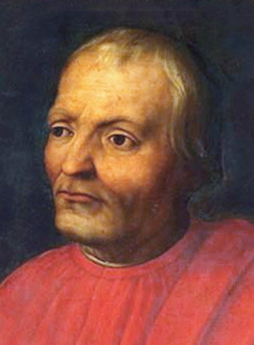 The rise of the Medici to power began under Giovanni, who founded the
family bank in 1397 … in competition with the Albizzi family of
Florence – who had previously taken command of the Tuscan banking realm
when the Bonsignori family of Siena went bankrupt a century earlier in
1298. Giovanni was able to extend the Medici banking position by
placing banking branches in Venice, Geneva … and most importantly, in
Rome (and briefly in Naples) … managing the Church's finances. This of
course would bring the Medici into fierce competition with other
banking families for the position as financial foundation of the Church. The rise of the Medici to power began under Giovanni, who founded the
family bank in 1397 … in competition with the Albizzi family of
Florence – who had previously taken command of the Tuscan banking realm
when the Bonsignori family of Siena went bankrupt a century earlier in
1298. Giovanni was able to extend the Medici banking position by
placing banking branches in Venice, Geneva … and most importantly, in
Rome (and briefly in Naples) … managing the Church's finances. This of
course would bring the Medici into fierce competition with other
banking families for the position as financial foundation of the Church.
Cosimo di Giovanni de' Medici (1389-1464)
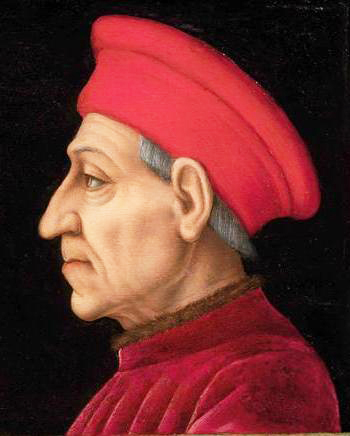 The battle between the Medici and Albizzi was especially a bitter one,
the Albizzi – in alliance with another powerful Florentine family, the
Strozzi – succeeding in having Giovanni's son, Cosimo, exiled by
Florence's Signoria (city council) in 1433. But when Cosimo relocated
to Venice, most of Florence's banking dynamics went with him … forcing
Florence a year later to lift the exile order and return Cosimo to
Florence. From then on Florentine politics found itself under the firm
direction of Cosimo … and much of the fast-rising art-world under his
enormous financial patronage. The battle between the Medici and Albizzi was especially a bitter one,
the Albizzi – in alliance with another powerful Florentine family, the
Strozzi – succeeding in having Giovanni's son, Cosimo, exiled by
Florence's Signoria (city council) in 1433. But when Cosimo relocated
to Venice, most of Florence's banking dynamics went with him … forcing
Florence a year later to lift the exile order and return Cosimo to
Florence. From then on Florentine politics found itself under the firm
direction of Cosimo … and much of the fast-rising art-world under his
enormous financial patronage.
Cosimo was also to send a condottiero (a commander of an
army-for-hire), Francesco Sforza, to Milan to secure matters after the
death of the head of the Visconti family governing that city.
Francesco had married the Visconti daughter Bianca years earlier …
Bianca being also the sole heir to the Visconti family. They would
henceforth rule Milan together. And thus Milan and Florence would also
form an important political bond.
Lorenzo di Piero de' Medici (1449-1492)
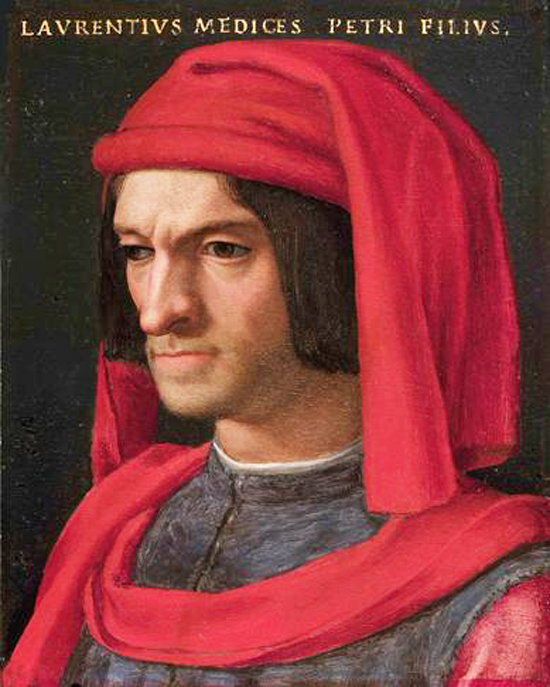 The Medici dynamic would reach its height under Cosimo's grandson,
Lorenzo, also known as "Lorenzo the Magnificent." Lorenzo was a huge
patron of the arts – supporting Verrocchio, da Vinci, Botticelli,
Michelangelo and many others. The Medici dynamic would reach its height under Cosimo's grandson,
Lorenzo, also known as "Lorenzo the Magnificent." Lorenzo was a huge
patron of the arts – supporting Verrocchio, da Vinci, Botticelli,
Michelangelo and many others.
Lorenzo's diplomacy also played a huge role in bringing peace to Italy
… most notably through the Treaty of Lodi (1454), ending the war
between Milan and Venice. On the basis of this treaty the Italic
League was founded. The Kingdom of Naples and the Papal states soon
joined the League … as did many other Italian city-states. This
therefore brought to Italy a relatively long period of peace, one
absolutely vital to the development of Renaissance Italy!
Of course his political and financial success made Lorenzo many very
jealous enemies … and an attempt was made on his life in 1478 (the
Pazzi conspiracy), which wounded him and killed his brother Giullano.
Lorenzo survived … but now found himself in bitter conflict with Pope
Sixtus IV, who had authorized the assassination attempt (Rovere family
versus Medici family?). When the Medici fought back, Sixtus seized
what Medici financial assets he could grab, put Florence under an
interdict (the Florentines had rallied to Lorenzo's support), allied
with the duke of Naples, and had an army sent to conquer Florence. The
war dragged on … until Lorenzo went to Naples and put himself at the
mercy of the king (Ferdinand I) and negotiated a peace finally.
Then things settled back down … so that Italy could continue forward in
peace. And this it did so, until shortly after Lorenzo's death in 1492.
|
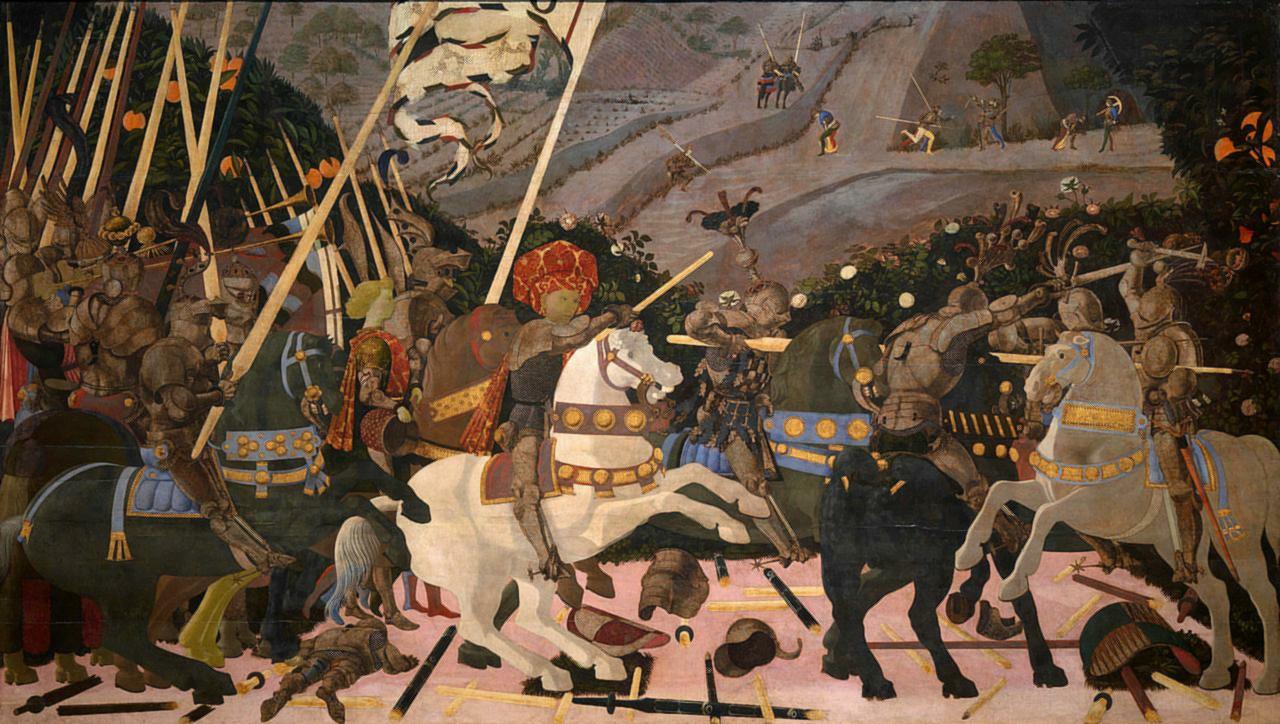
Florentines routing the Sienese
at the Battle of San Romano – 1432
(by Paolo Uccello – c. 1438-1440)
National Gallery, London
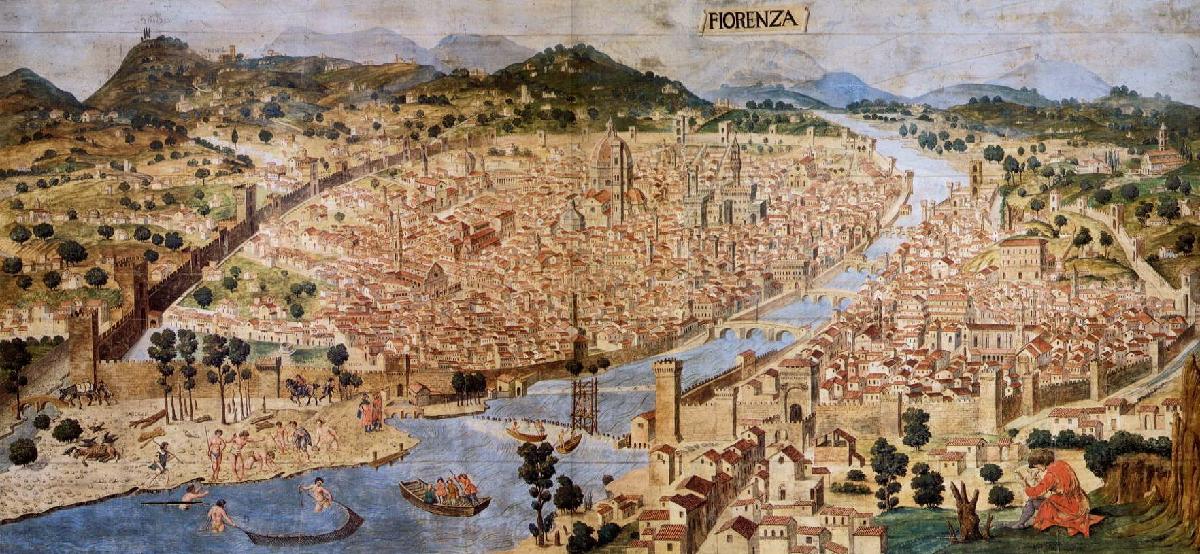
The "Carta della Catena": a
15th century view of Florence (c. 1490)
Florence, Museo de Firenze
Com'era
The Medicis of Florence

Lorenzo de' Medici – bust
by Andrea del Verrocchio
(1480)
Samuel Kress Collection,
National Gallery of Art, Washington, D.C.
OTHER ITALIAN
CITY-STATES AND THEIR "FIRST FAMILIES" |
The Sforzas of Milan
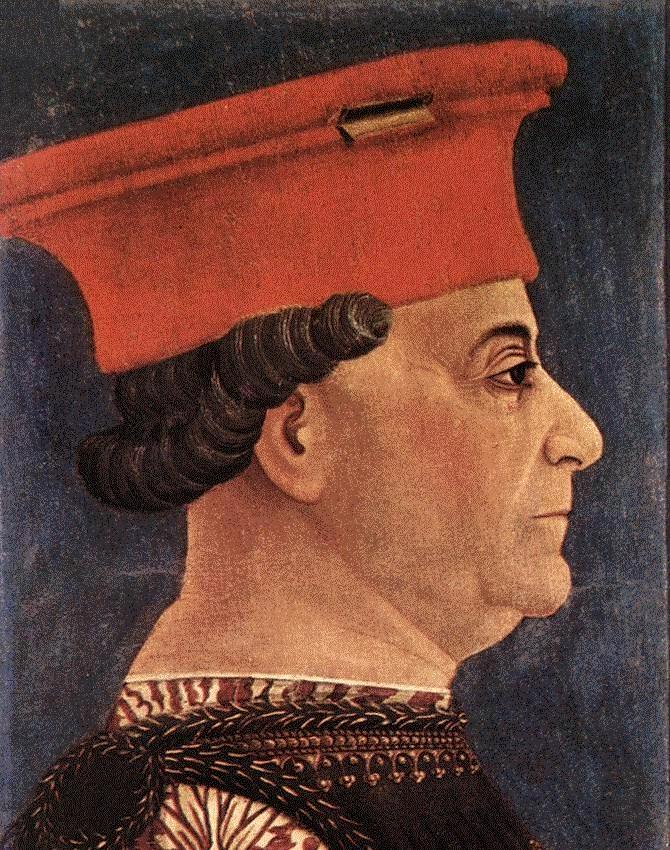
Francesco Sforza – Duke of
Milan 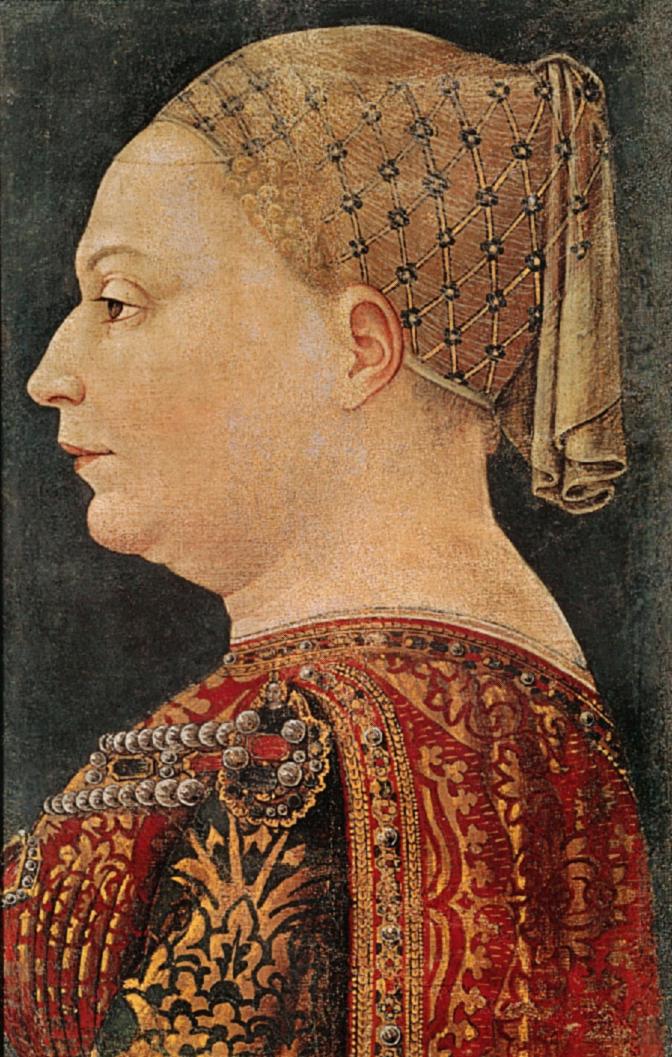
Bianca
(Visconti) Sforza
– his wife
Milan, Pinacoteca di
Brera

Ludovico Sforza and his wife
Beatrice – before the Virgin Mary and Christ Child
Ludovico was a major patron of Leonardo da Vinci, Bramante
and other artists;
unfortunately he was not as wise politically
as he was artistically,
inviting the French
into Italy – only to be undone by them
later
Milan, Pinacoteca di
Brera
The Gonzagas of
Mantua
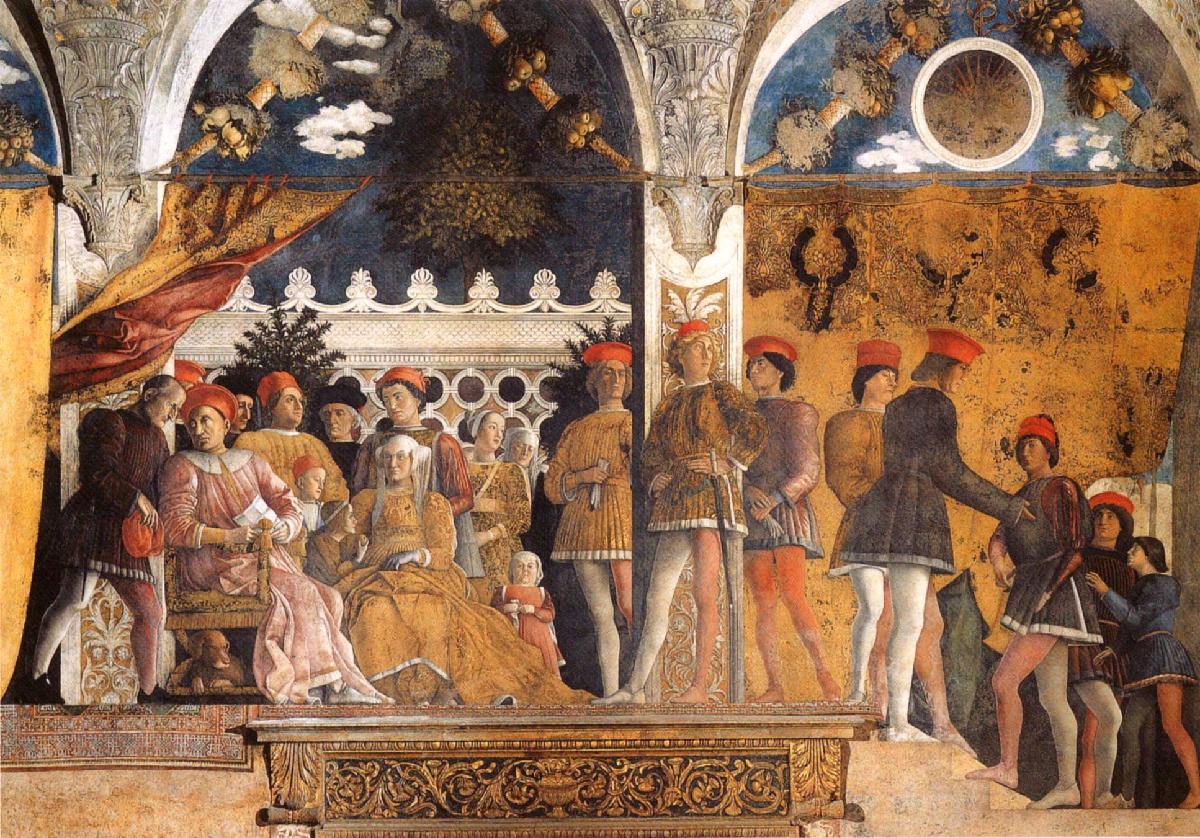
Andrea Mantegna's painting
of the family of Ludovico III Gonzaga, marquess of Mantua
Mantua, Ducal
Palace The
Montefeltros of Urbino
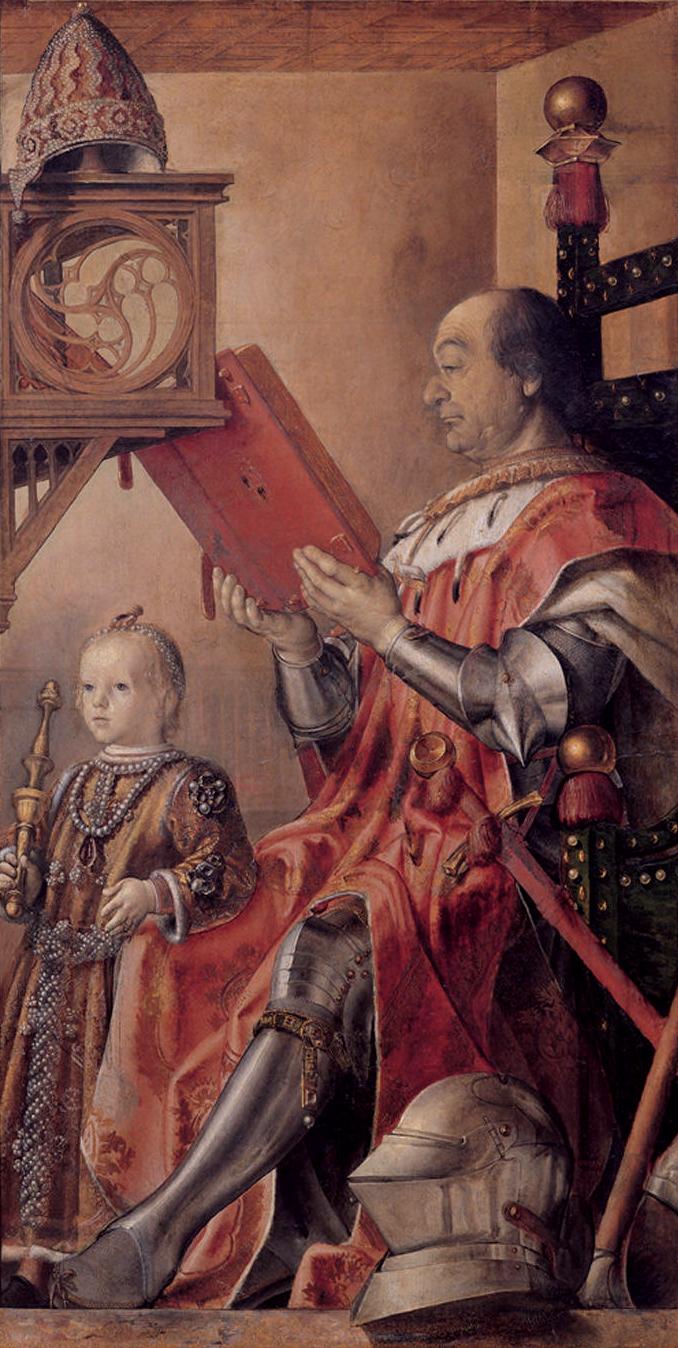
Frederico da Montefeltro,
Duke of Urbino – and his son, Guidobaldo (c. 1475)
Urbino, Galleria Nationale della
Marche
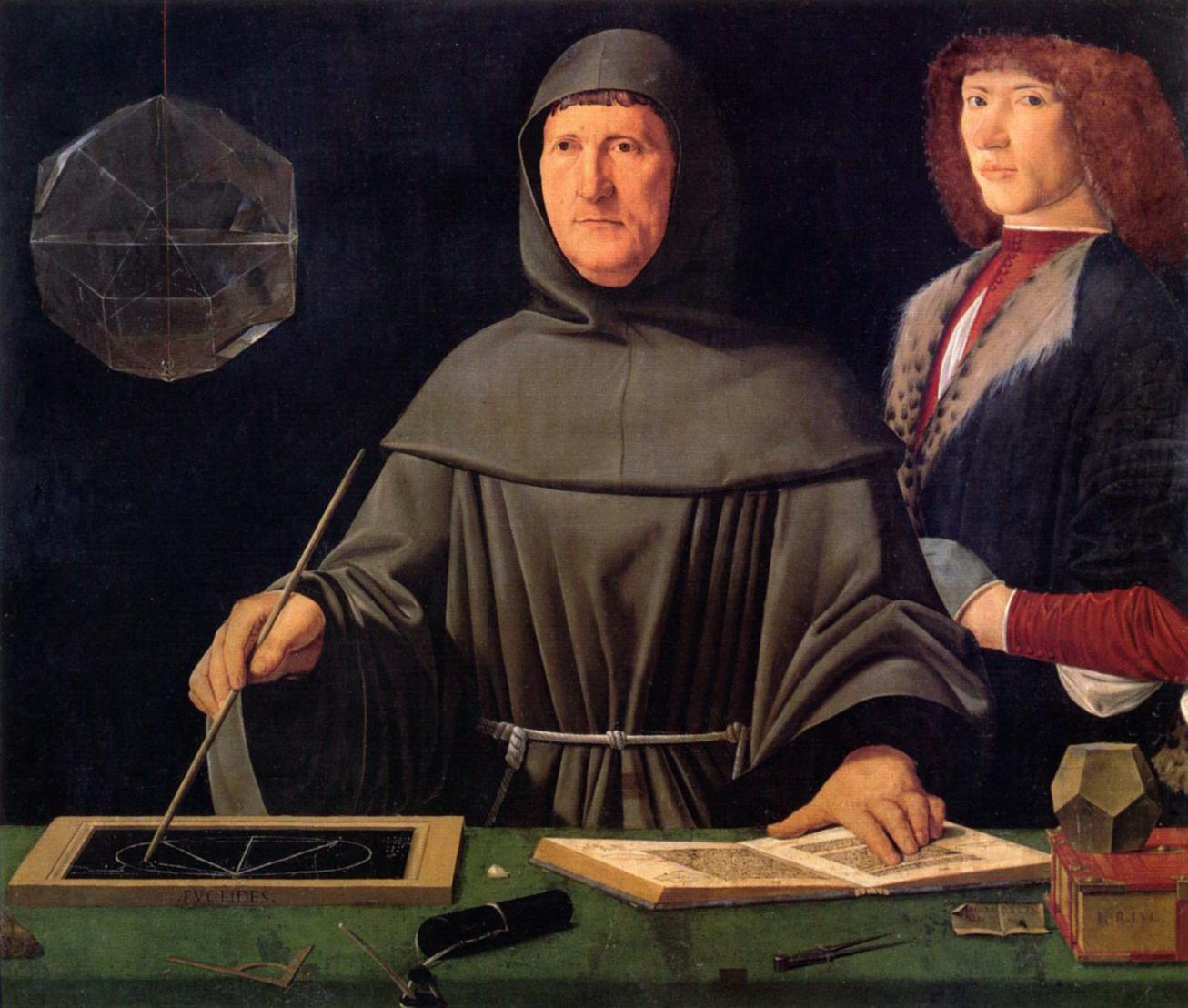
Franciscan monk and
mathematician
Luca Pacioli - by Jacopo de' Barbari
(with patron and student
Guidobaldo da Montefeltro, duke of Urbino)
Naples, Galleria Nazionale di
Capodimonte
The Strotzis of Naples (and Florence) 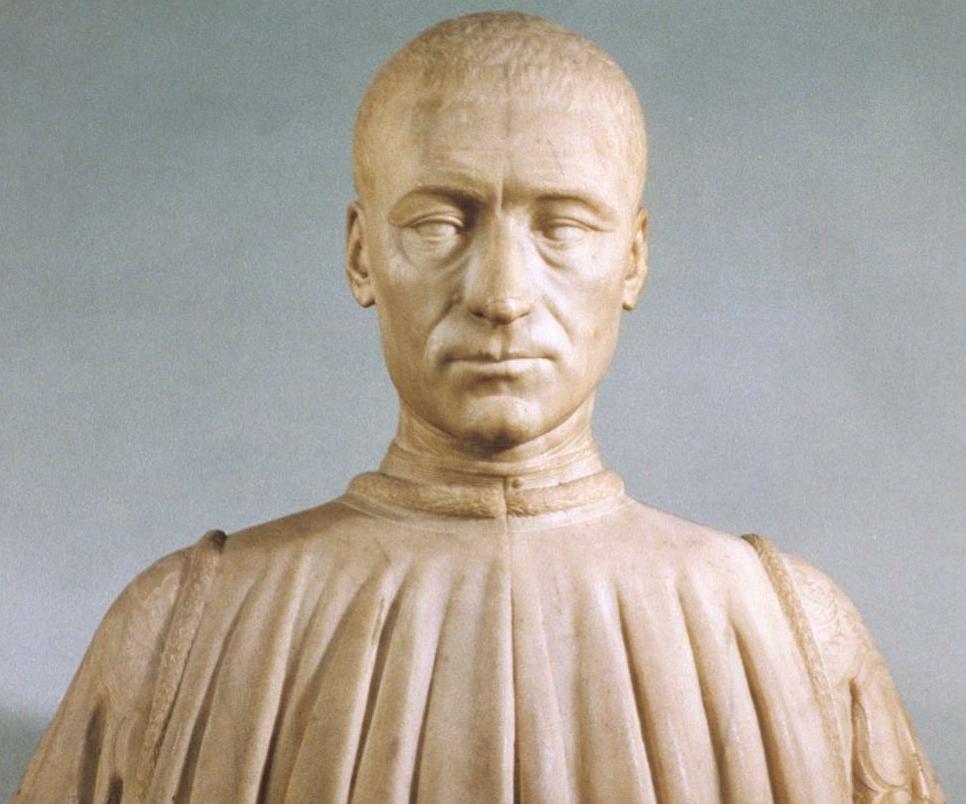
Merchant-banker Filippo
Strozzi
He developed a financial
empire in Naples
after the Medici drove the
Strozzi family out of Florence in 1434
Paris, Musée du
Louvrea name="Papacy"
As
already suggested, the Church chose to join the political action which
was disrupting Europe at the time. Certainly there were those who
objected to the Church taking up such a worldly manner. But by
and large, the view of the Church – notably of its popes, who during
the 1400s could be very worldly fellows – was that intellectual
revolution and political intrigue were things to be pursued.
Indeed, the papacy was as much an object of dynastic competition as the
kingdoms and republics were proving to be. Families such as the
Roveres, the Borgias, the Medici, constantly vied for the all-important
papal appointment by the College of Cardinals. Thus the church
was as active a player in the Renaissance political game as were the
European kingdoms, duchies and republics.
Pope Sixtus IV (pope 1471-1484)
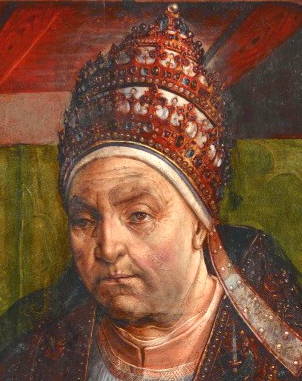 For instance, Pope Sixtus IV (Francesco della Rovere) was both a grand
patron of the arts and letters, constructing the Vatican's Sistine
Chapel and developing the Vatical Archives … as well as bringing
various artists to Rome to develop Rome's own artistic age. But,
as we have seen, he was an organizer of the Pazzi conspiracy, designed
to destroy the Medici family. He also annulled the decrees
of the Council of Constance, which had tried to bring the Church under
the control of an ecumenical council rather than under the singular
rule of the pope. And he authorized the Spanish Inquisition in
1478 … in an effort to eliminate those of the Jewish community who had
chosen to convert to Christianity rather than face expulsion … and
whose true Christian loyalties were thus highly suspect. In all
likelihood, this round of the Inquisition was in part of an effort of
the Spanish to demonstrate clearly that their former tolerance of
Muslims and Jews (which had earned the Spanish Christians the
reputation in the rest of the Christendom as being less that "pure"
Christians) had come to an end. For instance, Pope Sixtus IV (Francesco della Rovere) was both a grand
patron of the arts and letters, constructing the Vatican's Sistine
Chapel and developing the Vatical Archives … as well as bringing
various artists to Rome to develop Rome's own artistic age. But,
as we have seen, he was an organizer of the Pazzi conspiracy, designed
to destroy the Medici family. He also annulled the decrees
of the Council of Constance, which had tried to bring the Church under
the control of an ecumenical council rather than under the singular
rule of the pope. And he authorized the Spanish Inquisition in
1478 … in an effort to eliminate those of the Jewish community who had
chosen to convert to Christianity rather than face expulsion … and
whose true Christian loyalties were thus highly suspect. In all
likelihood, this round of the Inquisition was in part of an effort of
the Spanish to demonstrate clearly that their former tolerance of
Muslims and Jews (which had earned the Spanish Christians the
reputation in the rest of the Christendom as being less that "pure"
Christians) had come to an end.
Innocent VIII (pope 1484-1492)
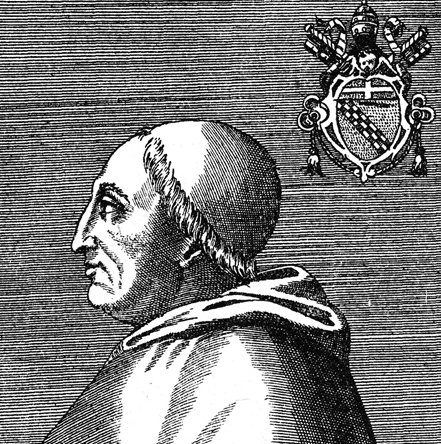 Sixtus was followed by Innocent VIII (Giovanni Battista Cybo). As
the son of the viceroy of Naples (the next most important person behind
King Ferdinand I), Cybo worked his way up the clerical ranks until,
with Rovere's help – and despite King Ferdinand of Naples' opposition
(Ferdinand wanted Rodrigo Borgia as pope) – he became pope. Sixtus was followed by Innocent VIII (Giovanni Battista Cybo). As
the son of the viceroy of Naples (the next most important person behind
King Ferdinand I), Cybo worked his way up the clerical ranks until,
with Rovere's help – and despite King Ferdinand of Naples' opposition
(Ferdinand wanted Rodrigo Borgia as pope) – he became pope.
Alexander VI (pope 1492-1503)
 Then the Borgia family found itself back in power when Rodrigo Borgia was elected to the papacy as Alexander VI. Then the Borgia family found itself back in power when Rodrigo Borgia was elected to the papacy as Alexander VI.
Part of the prominent Borgia family of Aragon, Rodrigo became a
cardinal after his uncle was elected as Pope Callixtus III (1455-1458),
and he served the next four popes in various offices – until his
election as pope in 1492. Alexander was a strong supporter of the
Church and its political powers … but also a strong supporter of the
Borgia family and its powers as well. And personally, he let no
lust stand in his way!
His illegitimate son, Cesare, became a prominent condottiero … after
having served briefly as a Catholic cardinal upon his father's election
as pope. But he resigned to serve French King Louis XII in the
latter's military ventures in both Northern and Southern Italy … aided
immensely in taking on his own political realm in the process through
his father's influence. But after his father Rodrigo's death in
1503 – and the election of a political rival Giuliano Della Rovere as
Pope Julius II (nephew of Pope Sixtus IV) – Cesare's fortunes would
change … despite his very strong military talents. Cesare would
eventually become the model for Machiavelli's Prince … a strong,
ruthless leader – who Machiavelli hoped would unite Italy.
Eventually Cesare was betrayed and murdered (1507) in one of the
political games shaking Italy at the time.
Cesare's sister Lucrezia was considered quite the beauty, married three
times, had affairs with others, and was mother of ten children … and
was also very much a part of the program of political intrigue in the
Borgia family's quest for power and status.
And so things went in Renaissance Italy!
Julius II (1503-1513)
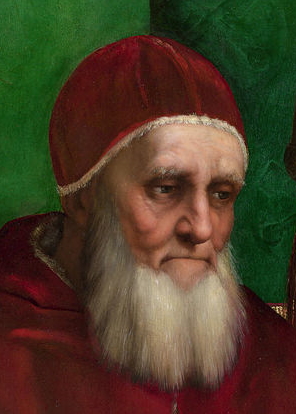 Not only did Pope Julius take on rather successfully the Borgia family
but, through much clever political intrigue, was able to extend the
power of the papacy in a supposed effort to bring some degree of peace
and stability to Italy. He brought Swiss Guards to serve as his
military arm, conducted treaties of military alliance with various
European princes, hired the artist Michelangelo to do the famous
paintings in the Sistine Chapel … and ordered the selling of
indulgences (payments to the Church designed to speed the sinner
through Purgatory … and onward to Heaven after death) in order to
finance the building of the massive Saint Peter's Basilica. Again
… his role as pope was very much more a matter of personal politics
than moral or spiritual leadership. Not only did Pope Julius take on rather successfully the Borgia family
but, through much clever political intrigue, was able to extend the
power of the papacy in a supposed effort to bring some degree of peace
and stability to Italy. He brought Swiss Guards to serve as his
military arm, conducted treaties of military alliance with various
European princes, hired the artist Michelangelo to do the famous
paintings in the Sistine Chapel … and ordered the selling of
indulgences (payments to the Church designed to speed the sinner
through Purgatory … and onward to Heaven after death) in order to
finance the building of the massive Saint Peter's Basilica. Again
… his role as pope was very much more a matter of personal politics
than moral or spiritual leadership.
Leo X (1513-1521)
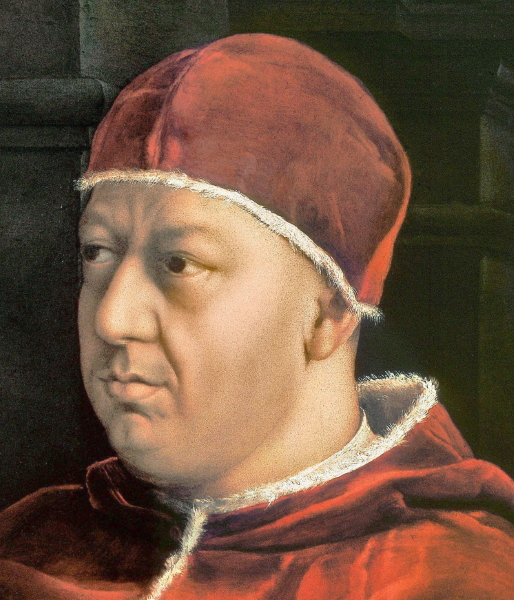 Giovanni di Lorenzo de' Medici, in becoming Pope Leo X, finally brought
the Medici family to full center stage in terms of church
politics. He was a massive spender of church funds – using such
funds extensively to bring his nephew to power in Urbino as its duke –
and having to sell "indulgences"7 to the faithful in order to cover the
massive costs involved in building the new St. Peter's Basilica. Giovanni di Lorenzo de' Medici, in becoming Pope Leo X, finally brought
the Medici family to full center stage in terms of church
politics. He was a massive spender of church funds – using such
funds extensively to bring his nephew to power in Urbino as its duke –
and having to sell "indulgences"7 to the faithful in order to cover the
massive costs involved in building the new St. Peter's Basilica.
He would also be the pope who would answer Luther's call (his 95
Theses) for church reform with the papal bull of 1520 condemning Luther
and his challenge … helping to break the ranks of Christian Europe into
two fiercely opposing theological parties of Catholics and Protestants.
7An
indulgence was a way of paying for one's sins … usually an act of
confession, prayer or good works. But by the time of Leo,
they were monetary contributions made by the people to the papacy
specifically for the work on St. Peter's Basilica … contributions that
would – according to the Pope's Grand Commissioner (chief indulgence
salesman), Johann Tetzel – help speed their soul through purgatory on
the road to heaven.
The Notorious Borgias (originally
Spanish)
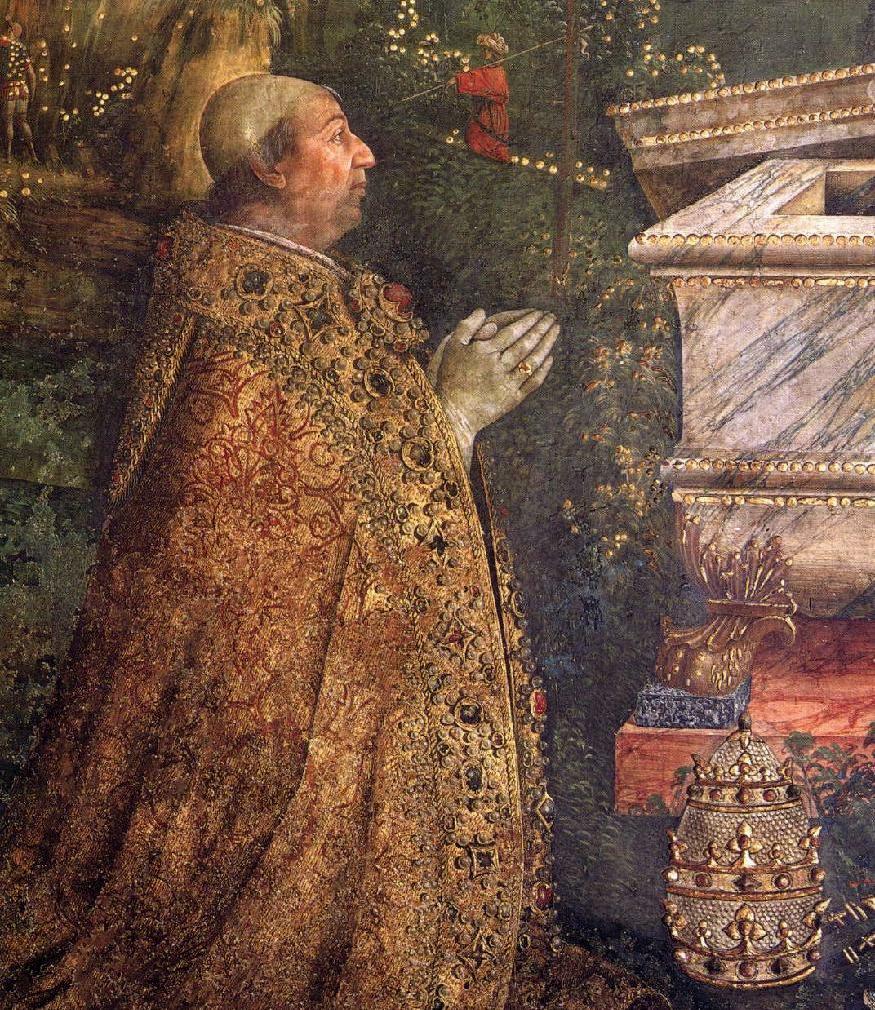
His Holiness, Rodrigo Borgia, Pope Alexander
VI (1492-1503)
Appartamento Borgia, Vatican
City

Caesar Borgia – son of
Pope
Alexander VI
(the inspiration for Machiavelli's
Prince)
Bergamo,
Accademia Carrara di Belle Arti

Lucrezia Borgia –
daughter
of Alexander VI and sister of Caesar Borgia
Portrayed as St. Catherine of Alexandria - by
Pinturicchio
Sala del Santi
- Appartamento Borgia, Vatican
City
THE "ITALIAN WARS" 1494-1559 |
In 1494, Charles VIII of France saw an opportunity, and invaded Italy
on the basis of a dynastic claim to Milan. This would set off a series
of "Italian Wars," involving claims and counter-claims to Italian
territory of the French Valois and the Spanish and Austrian Habsburgs –
in alliance with one or another of the Italian city-states … and with
the popes deeply involved in the process. The whole thing turned very
ugly … and very lasting in that ugliness.
|

Charles VIII and his French
troops enter Florence – November 17, 1494 – by Francesco
Granacci
Ufizzi, Florence
THE TURKS ON THE RISE IN THE EAST |
|
Mehmed I (r. 1413-1420)
The Ottomans' humiliating defeat by Tamerlane's forces was followed by
a decade of civil war (the "Interregnum") … as Bayezid’s sons battled
among themselves for the position of Ottoman Sultan. Finally in
1413, one of the sons, Mehmed I, emerged victorious and was able to
reunite the Ottoman Sultanate. Three of the brothers were killed
… though another brother Mustafa and nephew continued to challenge him
during his reign.
Under Mehmed’s direction, Albania in the West and the Armenian Kingdom
of Cilicia in the East were added to the Ottoman holdings.
Murad II (r. 1421-1444 and 1446-1451)
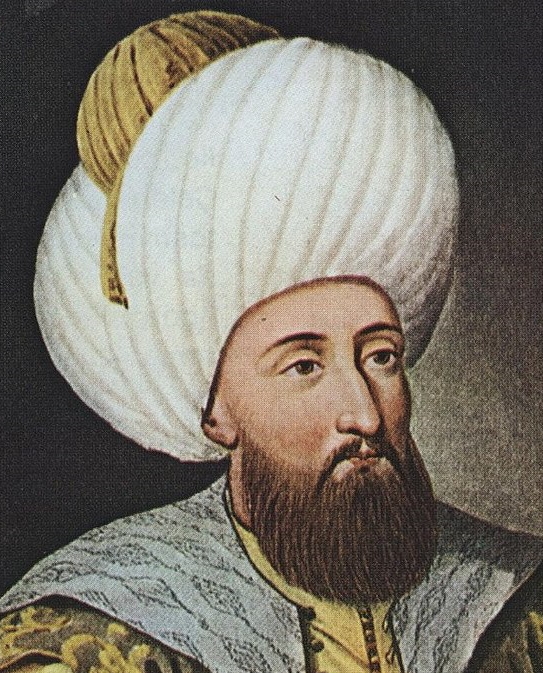 To secure his own power, Murad had to defeat his uncle Mustafa,
released from captivity by the Byzantine Emperor Manuel II in order to
block Murad. In defeating Mustafa, Murad received significant
help from the Genoese navy! An angry Murad then turned on
Constantinople … and backed off only when paid a huge tribute by the
Byzantines. At the same time, he took on and crushed numerous
beyliks in Anatolia that had been set up by Tamerlane. To secure his own power, Murad had to defeat his uncle Mustafa,
released from captivity by the Byzantine Emperor Manuel II in order to
block Murad. In defeating Mustafa, Murad received significant
help from the Genoese navy! An angry Murad then turned on
Constantinople … and backed off only when paid a huge tribute by the
Byzantines. At the same time, he took on and crushed numerous
beyliks in Anatolia that had been set up by Tamerlane.
The Byzantine Emperor then turned over to Venice some Byzantine lands …
in the effort to get Venice (a former Ottoman ally) to block further
Ottoman expansion. In response Murad looked to some of his
Christian allies in the Balkans to help him in what had become a Balkan
War … which eventually simply came to a halt (1444). Murad then
retired … and turned his government over to his young son, Mehmed.
Sensing an opportunity in this, Pope Eugenius IV soon called for
another crusade … designed to drive the Turkish "infidel" out of
Europe. This in turn brought Murad back out of retirement … to
direct Ottoman operations alongside his son Mehmed. Meanwhile,
Venice and Serbia had seemed unable to decide on which side to support
… weakening greatly the "Christian effort.
Also, having trouble with Turkish noblemen within his own domain, Murad
built to greater importance the devşirme – the system by which
Christian subjects were forced to turn over (often as many as 20
percent) of their male children … to serve as what would become highly
privileged Janissaries within the Ottoman ranks. With full
reliance on Janissary military support, Murad was able to bring his
Turkish noblemen under full control … and have at arms a military force
of enormous strength.
In 1448 Murad’s troops defeated the Albanians at the second battle of
Kosovo … bringing the Balkan powers (Thrace, Macedonia, Bulgaria,
Greece, Serbia and now Albania) under Ottoman mastery. Only the city of
Constantinople, the last position held by the dying Byzantine Empire,
still found itself unconquered by the Ottomans. But that was about to
change.
Mehmed II "the Conqueror" (1451-1481)
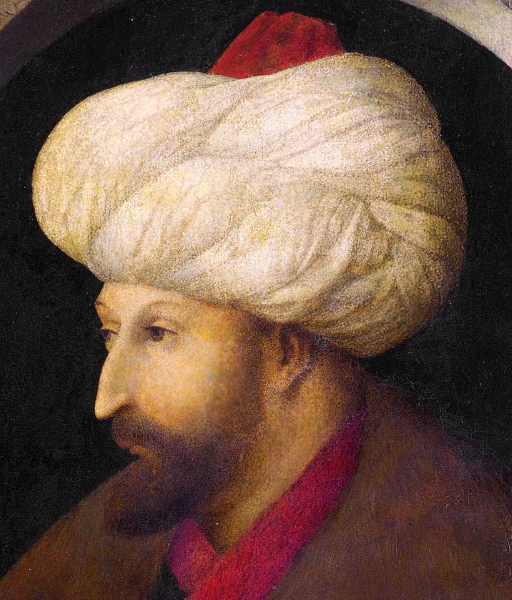 Soon after his father died (1451) Mehmed prepared to take on
Constantinople, building Rumeli Fortress near Constantinople to oversee
operations. When he was ready, in only a matter of weeks
(April-May 1453), Constantinople was finally conquered. Soon after his father died (1451) Mehmed prepared to take on
Constantinople, building Rumeli Fortress near Constantinople to oversee
operations. When he was ready, in only a matter of weeks
(April-May 1453), Constantinople was finally conquered.
Mehmed proved to be a very wise ruler. He chose to be merciful to
the inhabitants, because, recognizing both its strategic and symbolic
importance, Mehmed intended to make Constantinople his new multi-ethnic
(Muslim, Christian, Jewish) Ottoman capital. He also set up the
millet system allowing each religious group making up his empire to
continue to live according to their respective religious laws, customs,
languages under their own respective leaders … operating however in
full support of the presiding authority of the Ottoman Sultan. The
generosity of these terms in fact guaranteed that support (even from
Christians). But it caused grumbling among the old Turkish
nobility, leading Mehmed to move even more decidedly in the effort to
replace traditional feudal support of the unreliable Turkish noblemen
with the devşirme as the basis of his rule.
Selim I "The Grim" (r. 1512-1520)
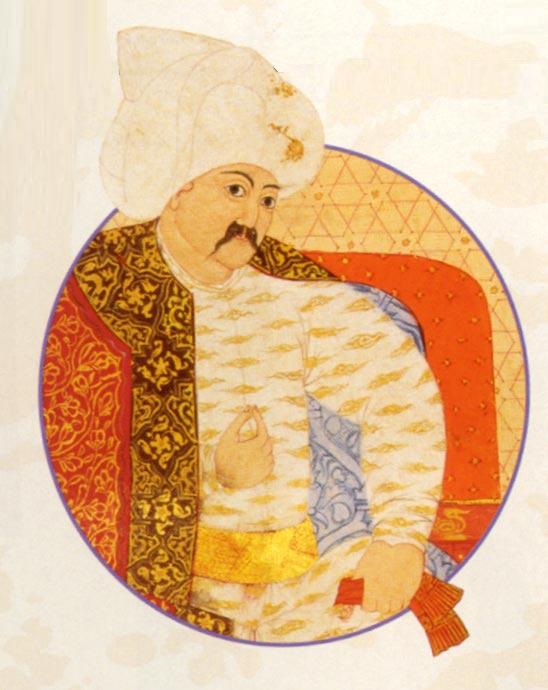
Over the run of the next series of sultans, Turkish expansion slowed up
… the Sultans having constantly to deal with rebellious Turkish
noblemen (and family members) within the Ottoman Empire. Finally,
under Selim I, the Ottoman empire was able to get back in the business
of Ottoman expansion, extending Ottoman rule into Egypt and northern
Iraq ... and making the Turkish navy a major force in the Eastern
Mediterranean.
Suleiman the Magnificent (r. 1520-1566)
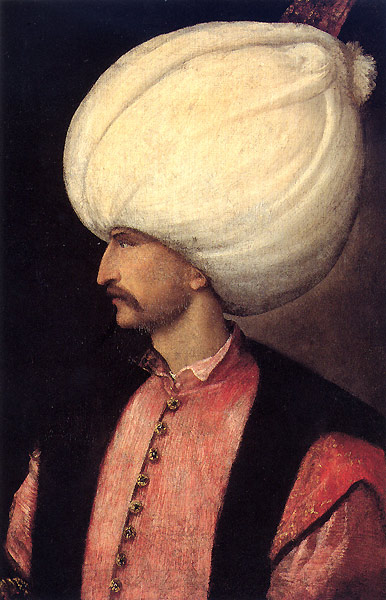 Suleiman was a contemporary of Charles of Habsburg and French King
Francis ... and adversary – or ally – of the two in the rough and
tumble European diplomacy of those times. Suleiman was a contemporary of Charles of Habsburg and French King
Francis ... and adversary – or ally – of the two in the rough and
tumble European diplomacy of those times.
Suleiman's troops expanded Ottoman power north against the Serbs and
Hungarians, and reached as far north as Vienna, the seat of Charles's
eastern empire. This assault against Charles's position in East
Europe rather naturally made Suleiman a military ally of Francis.
They joined forces in Hungary in support of the Turks … and along the
Mediterranean coast in the area between Southeastern France and
Northeastern Italy in support of France.
And although Suleiman ultimately failed to capture Vienna, his two
assaults there gave Luther and the Schmalkaldic League the opportunity
to build up their forces in Germany … ready to face the full wrath of
Charles, the "Defender of the Faith." And Francis, though
anti-Protestant, even allied with the German Schmalkaldic League
against Charles. So things went in those days.
|
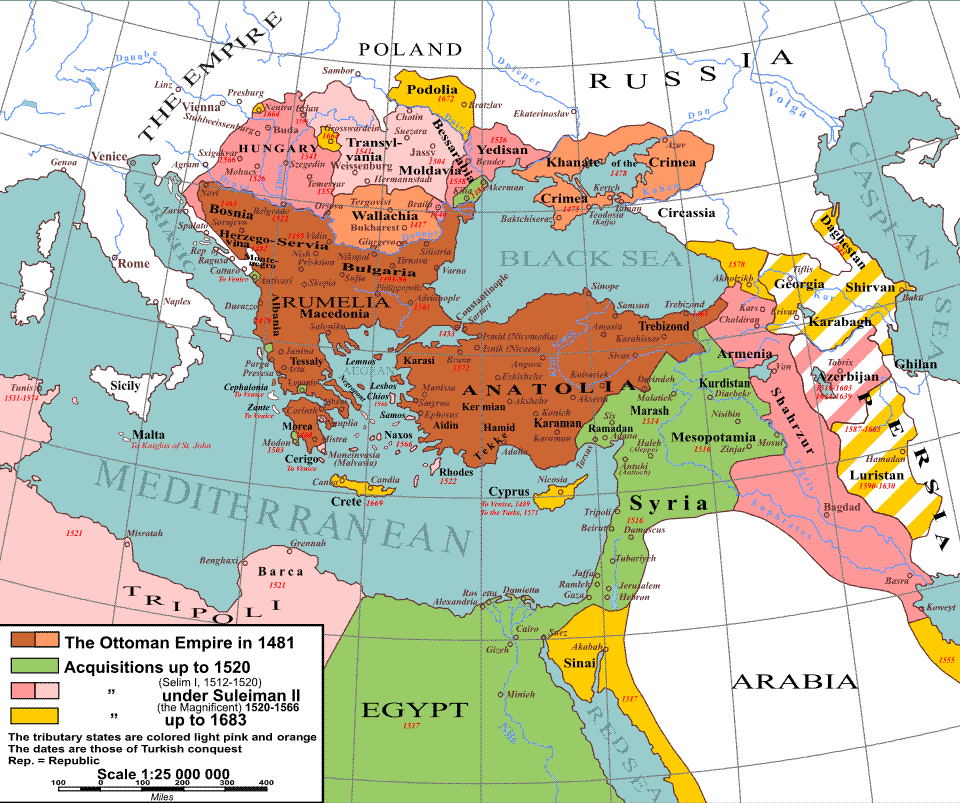
The Ottoman
Empire:
1481, 1520, 1566 and 1683
Wikipedia - "Ottoman
Empire"
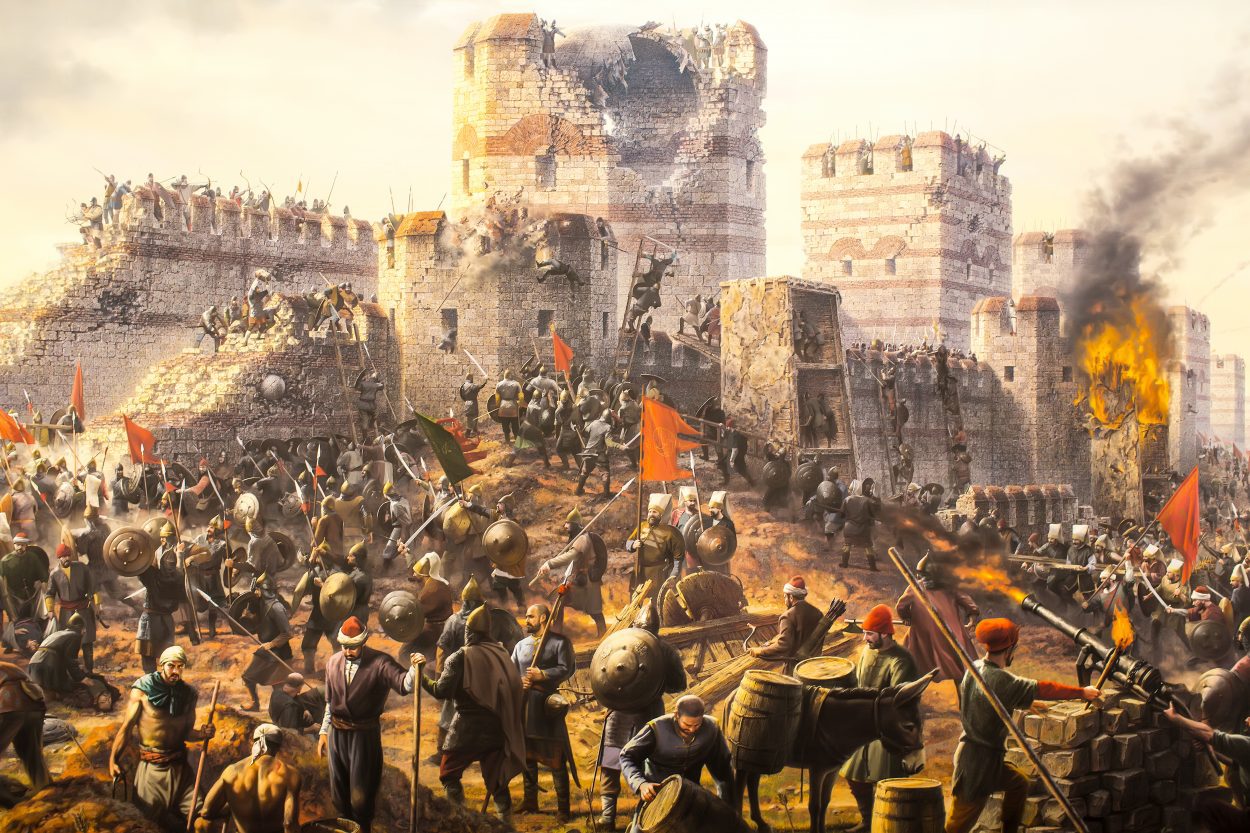
The Fall of Constantinople - 1453
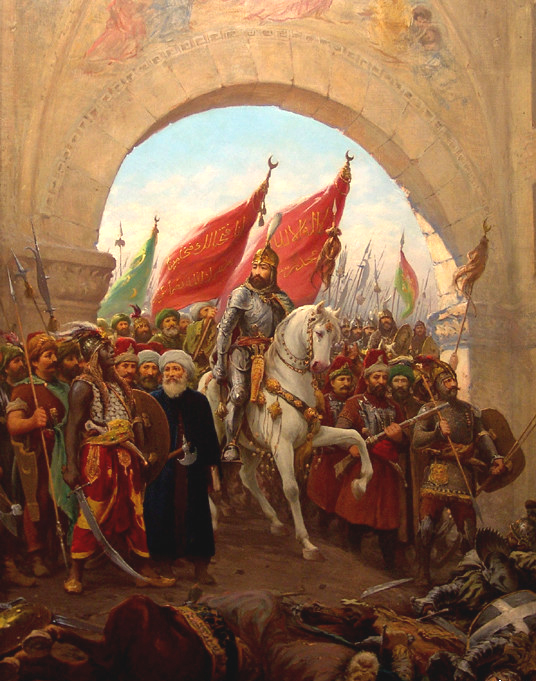
Mehmed II "The Conqueror" enters Constantinople - 1453 - by Fausto Zonaro
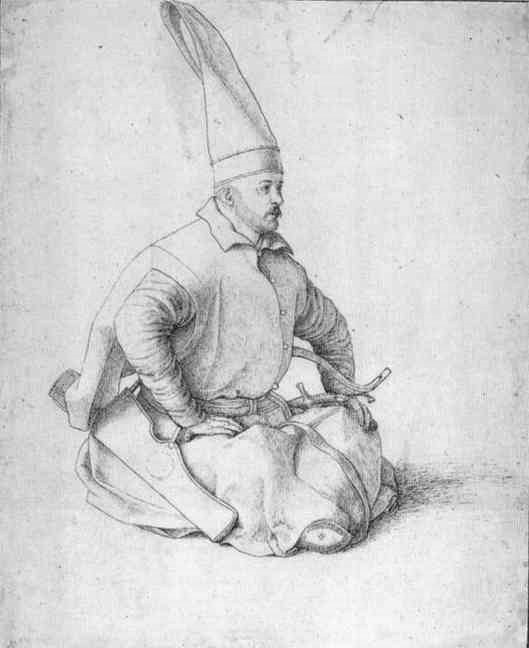
A 15th century Janissary
- drawing by Gentile Bellini
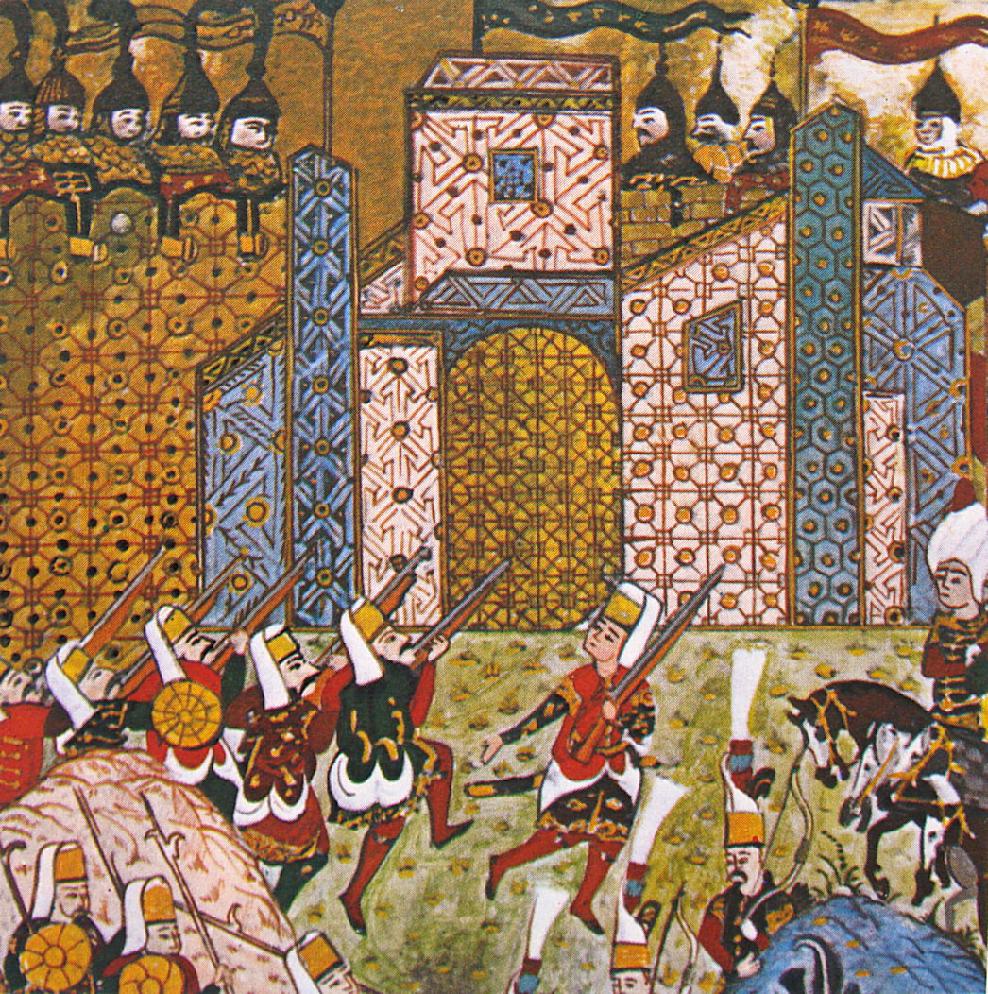
Suleiman's Janissary troops fighting the Knights of St. John at the Siege of Rhodes - 1522
The Turkish threat to the
Habsburg holdings in the East
(including the Habsburg
Eastern capital at Vienna)
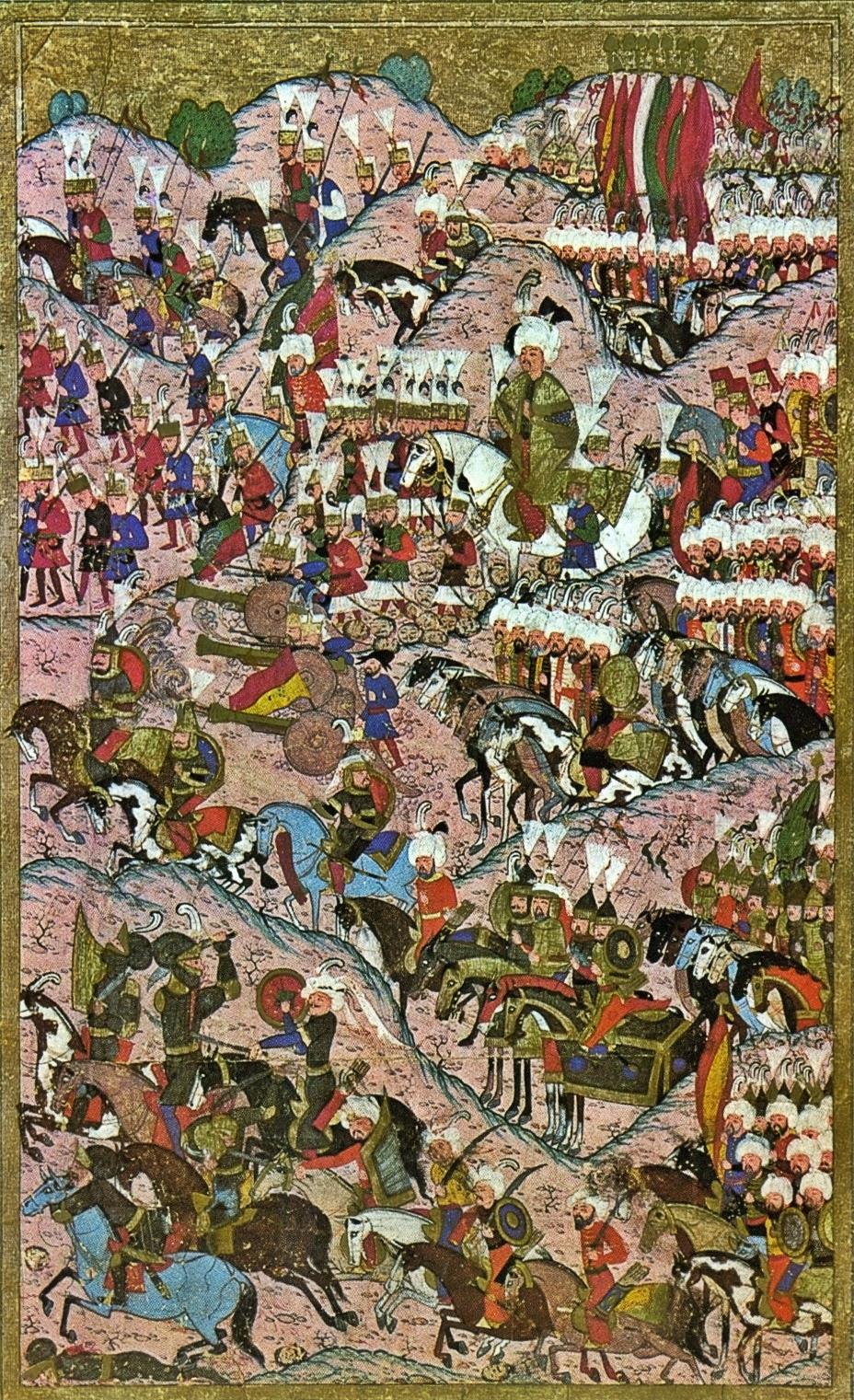
Suleiman defeating the Hungarians at Mohacs - 1526
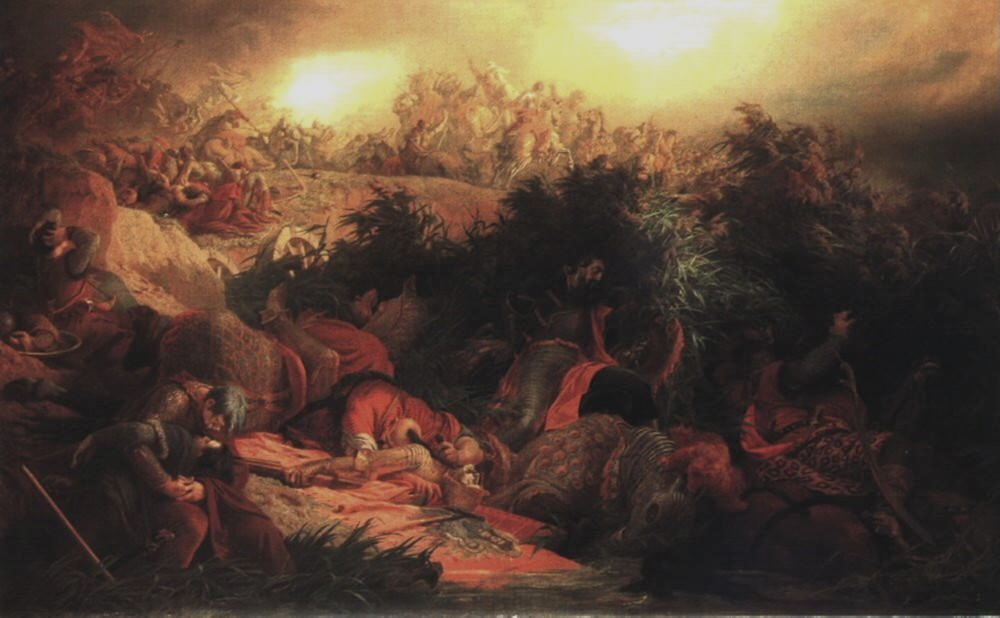
Another perspective on the Battle of Mohacs - 1526
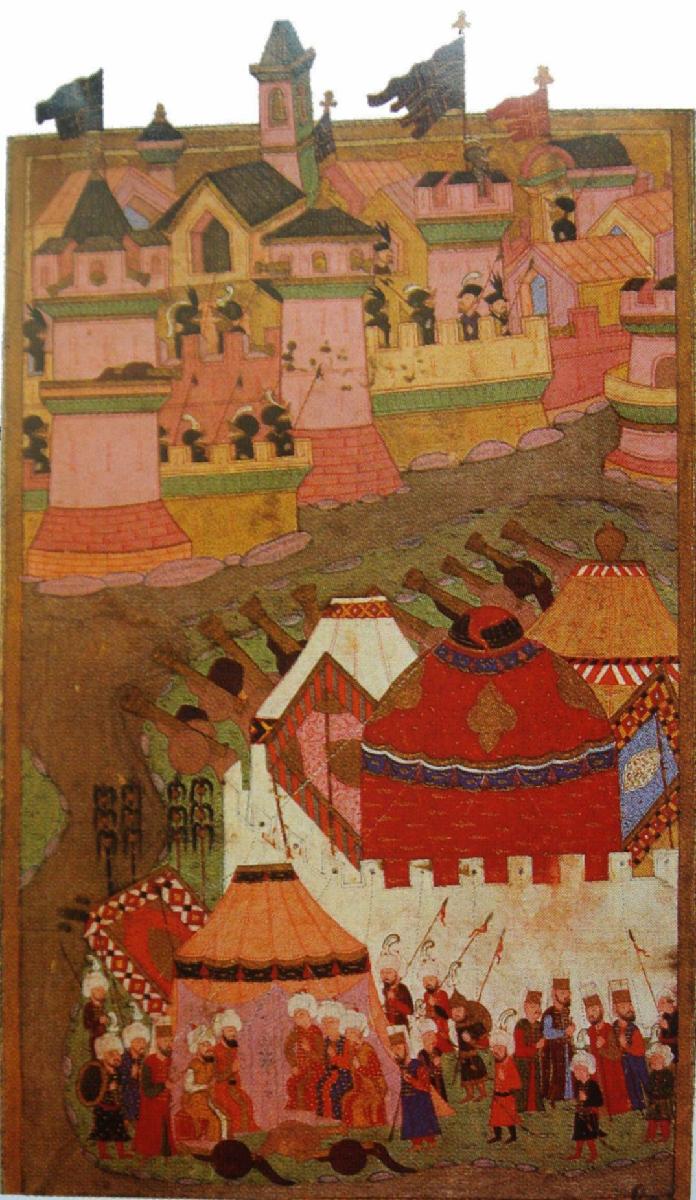
An Ottoman depiction of the
siege of Vienna of 1529 - from the 16th century
Hachette
Art Museum - Istanbul

Go on to the next section: The beginning of the Age of Exploration
 Miles
H. Hodges Miles
H. Hodges
| | | | |


 The Hundred Years' War (1337-1453)
The Hundred Years' War (1337-1453)
 Venice: The first of the grand Italian city-
Venice: The first of the grand Italian city- The Medici and Renaissance Florence
The Medici and Renaissance Florence
 Other Italian city-states and their "First
Other Italian city-states and their "First The "Italian Wars" (1494-1559)
The "Italian Wars" (1494-1559)
 The Turks on the rise in the East
The Turks on the rise in the East
 For more on Joan of Arc
For more on Joan of Arc Francis,
in his long reign, would exemplify the Renaissance Man in French office
… a major patron of the arts and letters – even as he continued French
involvement in the affairs of Italy. At the same time, he found
himself facing a new challenge in the rising Habsburg family, led by
Charles … who started out as Dutch Lord (to the North), then by
inheritance became King of Spain (to the South), and finally by
election Holy Roman Emperor (to the East). Finding himself thus
surrounded by this rising Habsburg power, Francis attempted an alliance
with English King Henry VIII. But not getting anywhere in the
effort, he instead formed an alliance with the rising Ottoman Turkish
Empire in Southeastern Europe ... principally with its Muslim sultan,
Suleiman (the Magnificent)! Quite a bold thing for a Christian
sovereign to do!
Francis,
in his long reign, would exemplify the Renaissance Man in French office
… a major patron of the arts and letters – even as he continued French
involvement in the affairs of Italy. At the same time, he found
himself facing a new challenge in the rising Habsburg family, led by
Charles … who started out as Dutch Lord (to the North), then by
inheritance became King of Spain (to the South), and finally by
election Holy Roman Emperor (to the East). Finding himself thus
surrounded by this rising Habsburg power, Francis attempted an alliance
with English King Henry VIII. But not getting anywhere in the
effort, he instead formed an alliance with the rising Ottoman Turkish
Empire in Southeastern Europe ... principally with its Muslim sultan,
Suleiman (the Magnificent)! Quite a bold thing for a Christian
sovereign to do!











































































